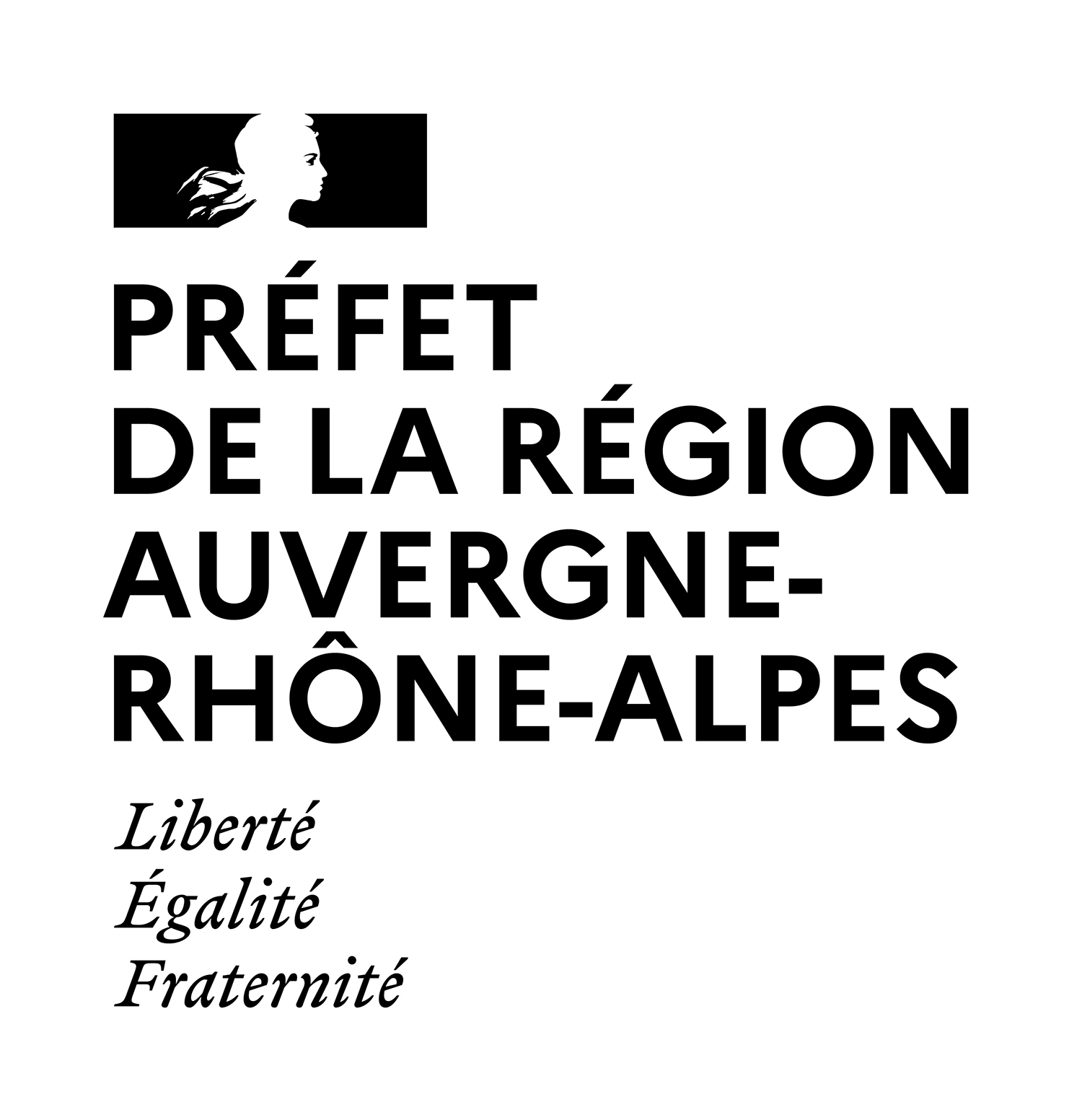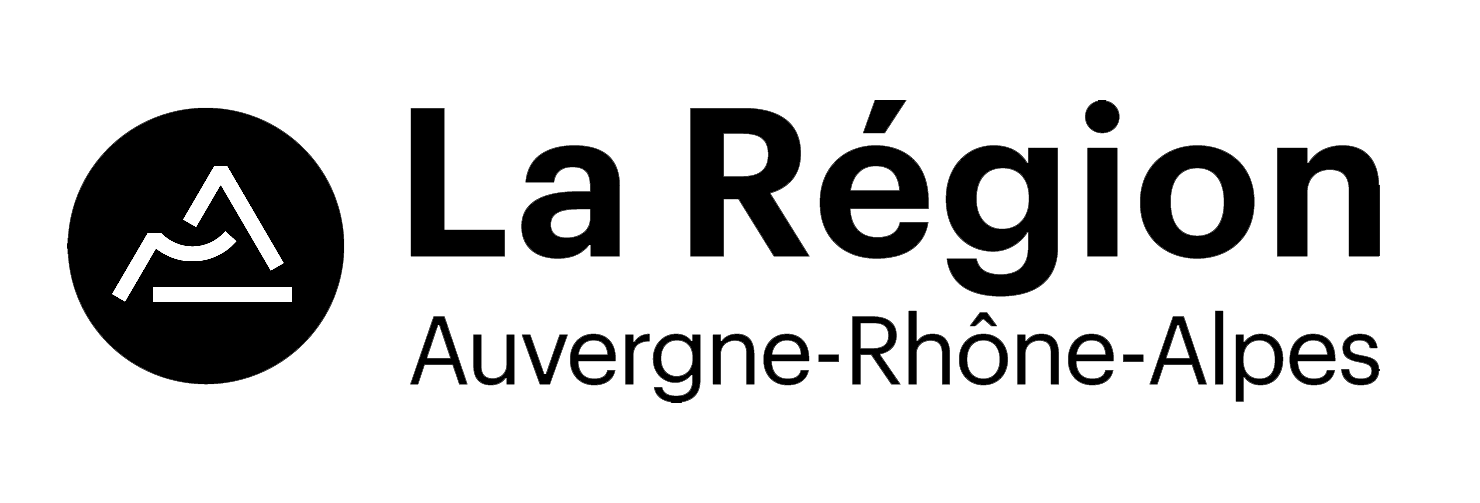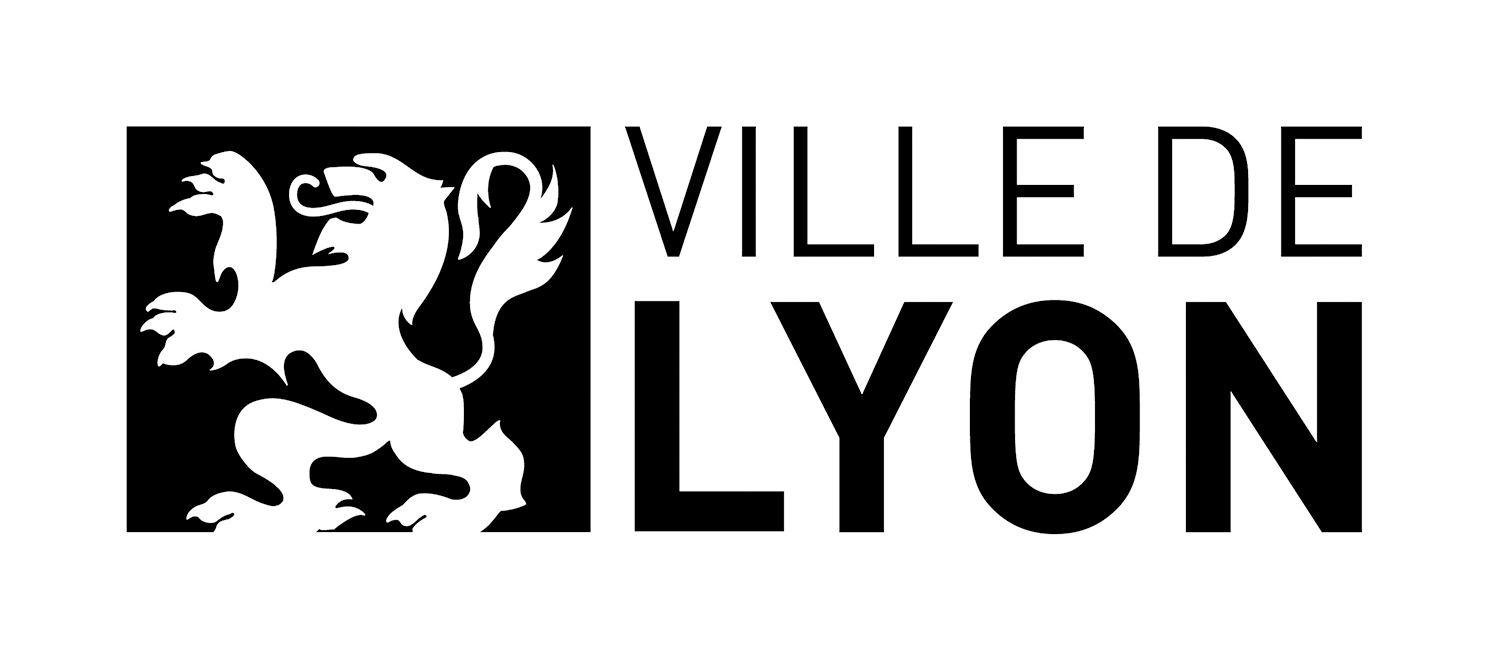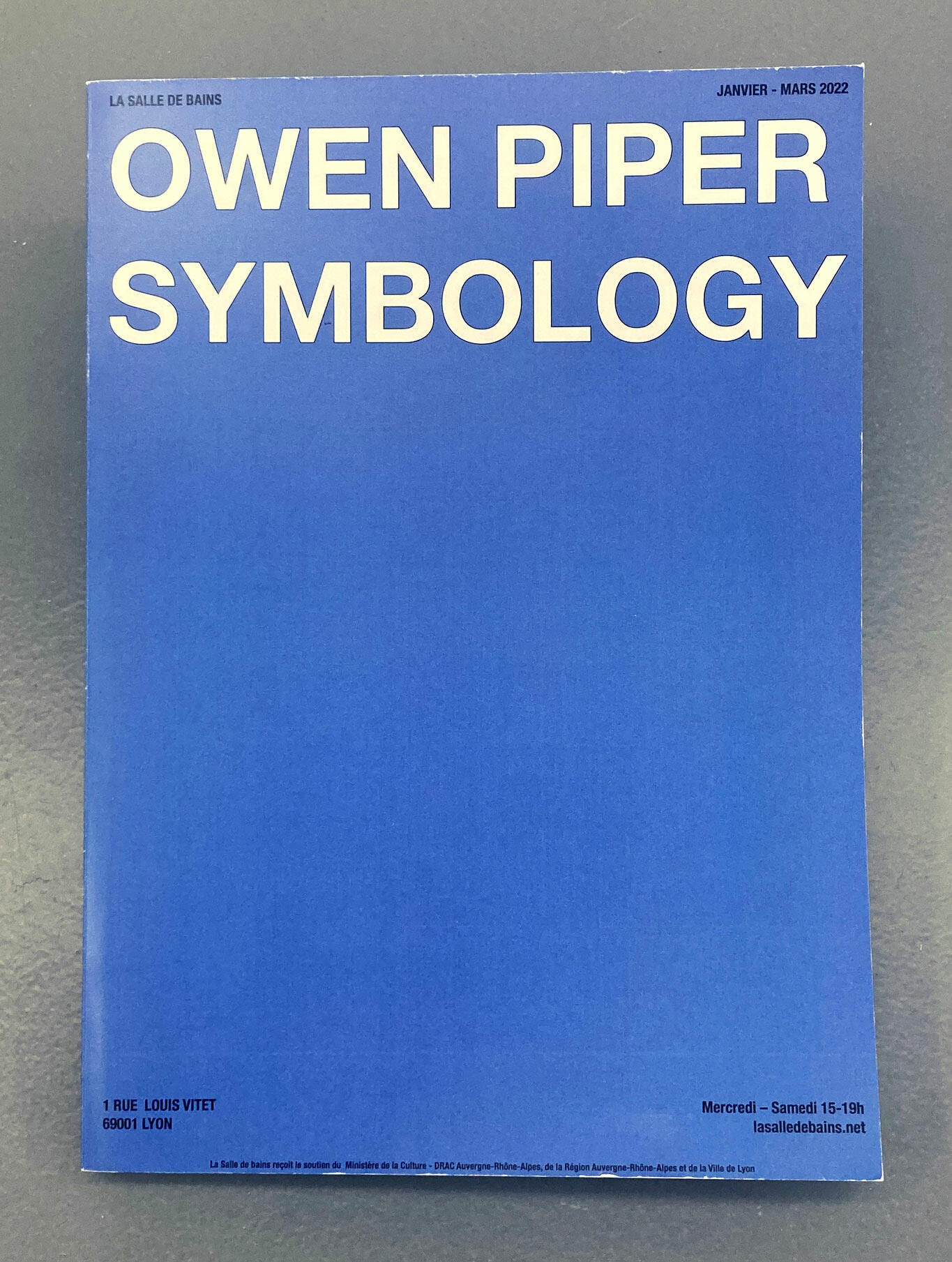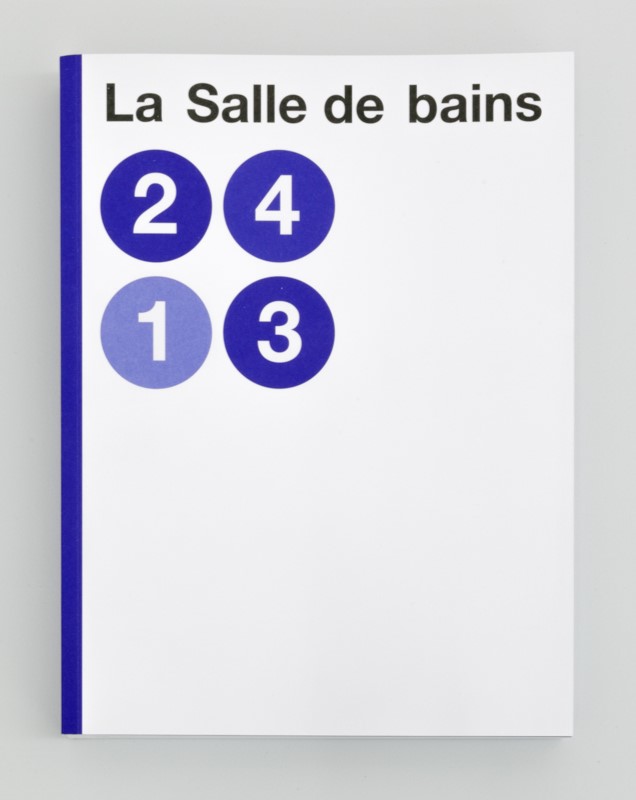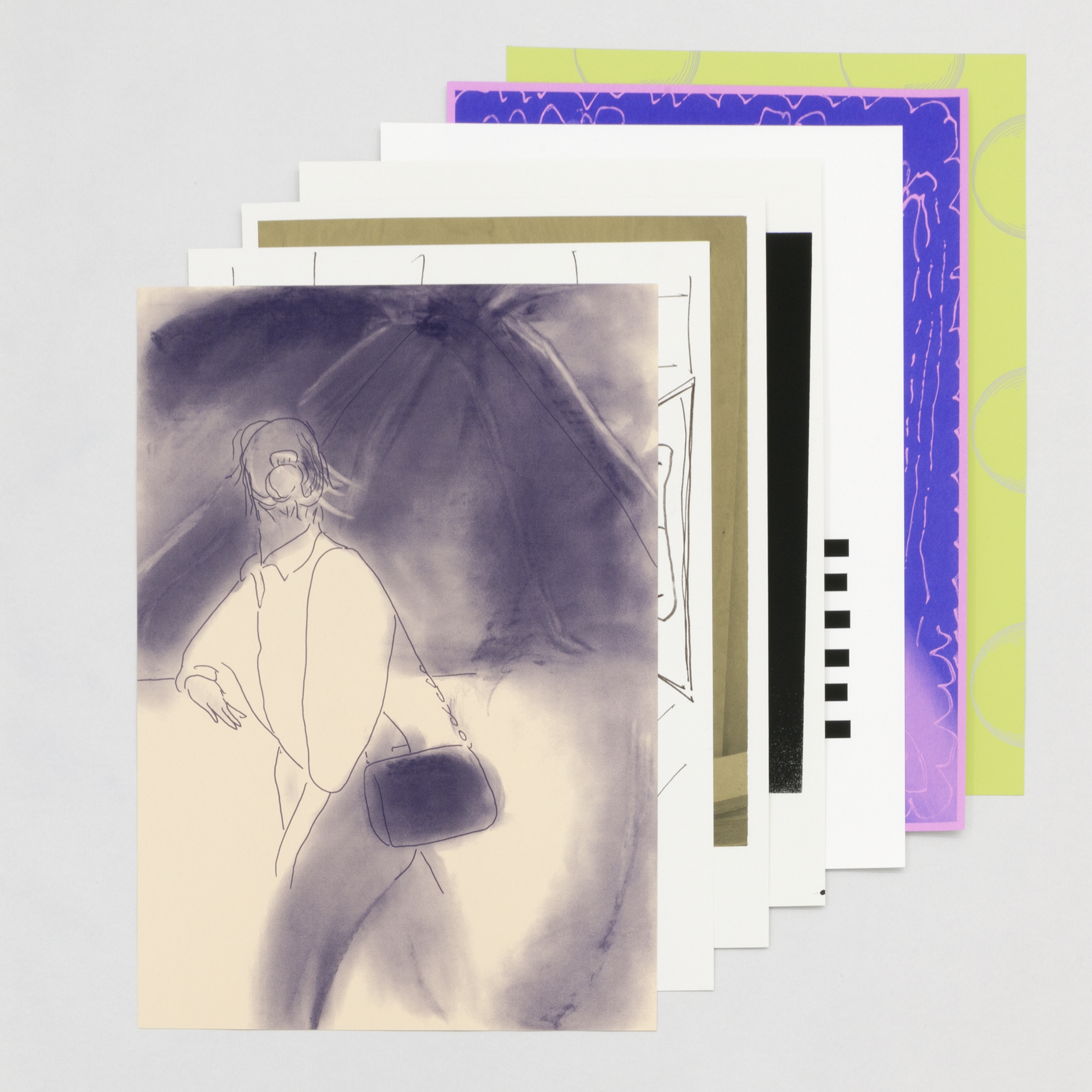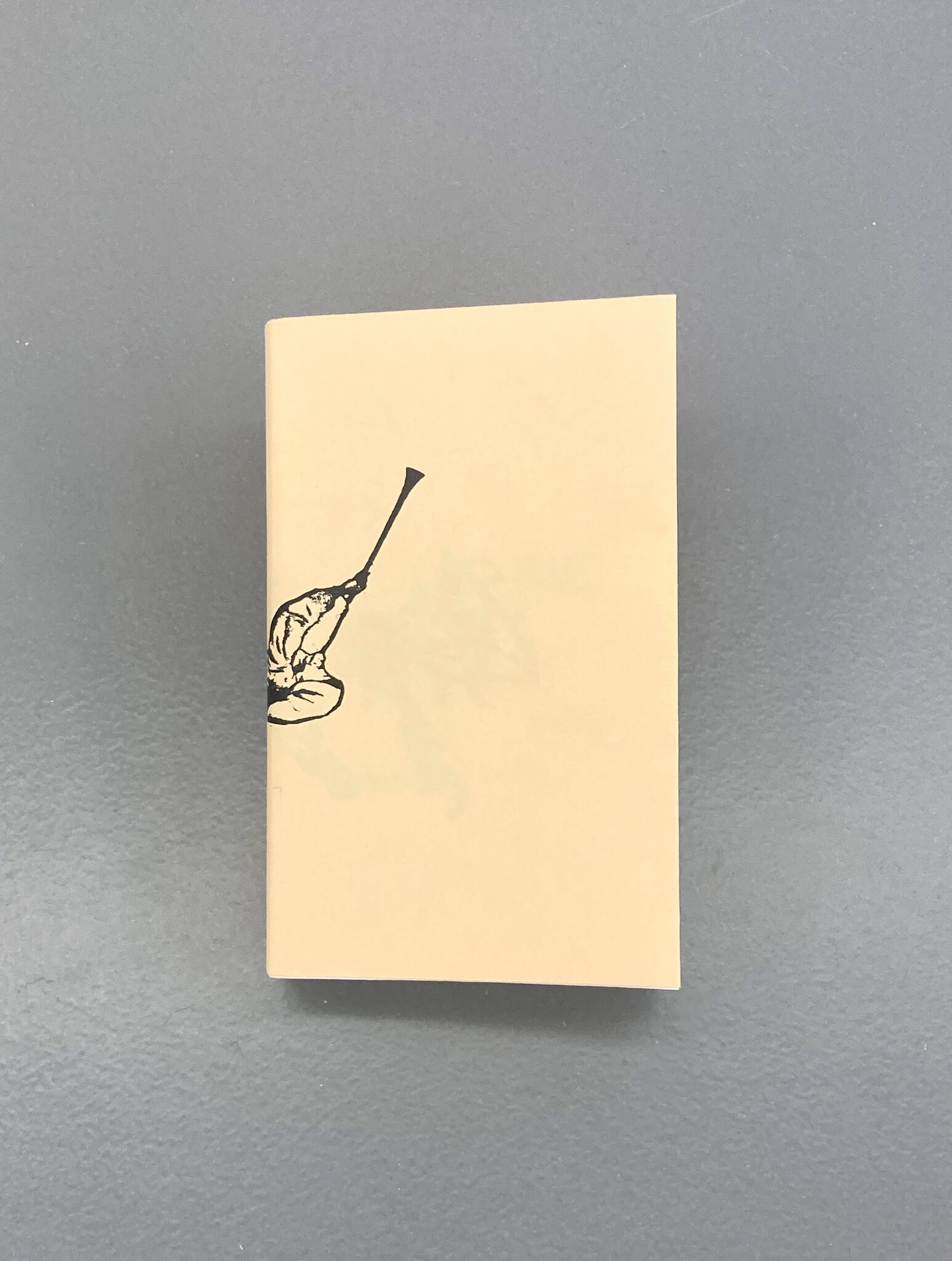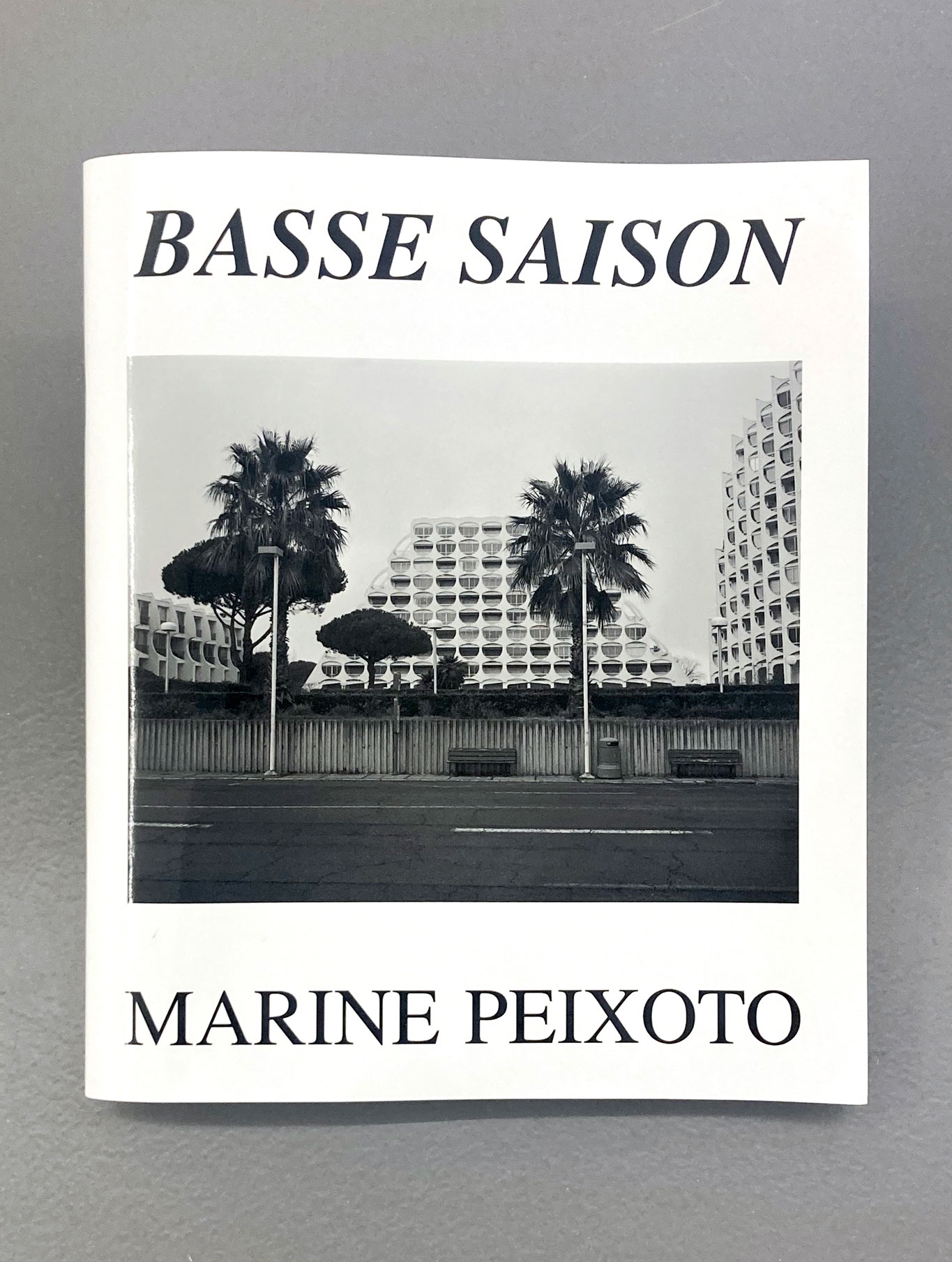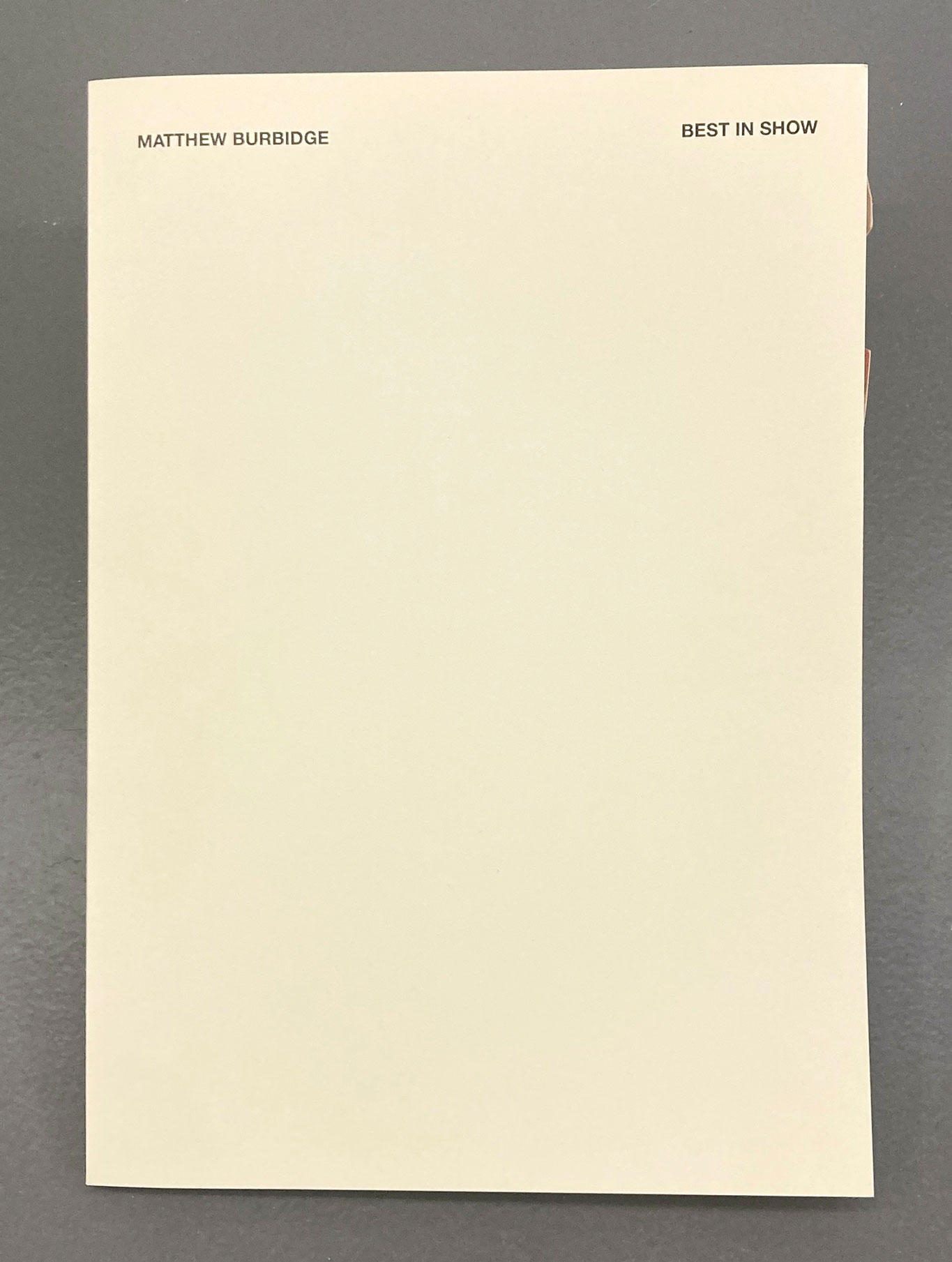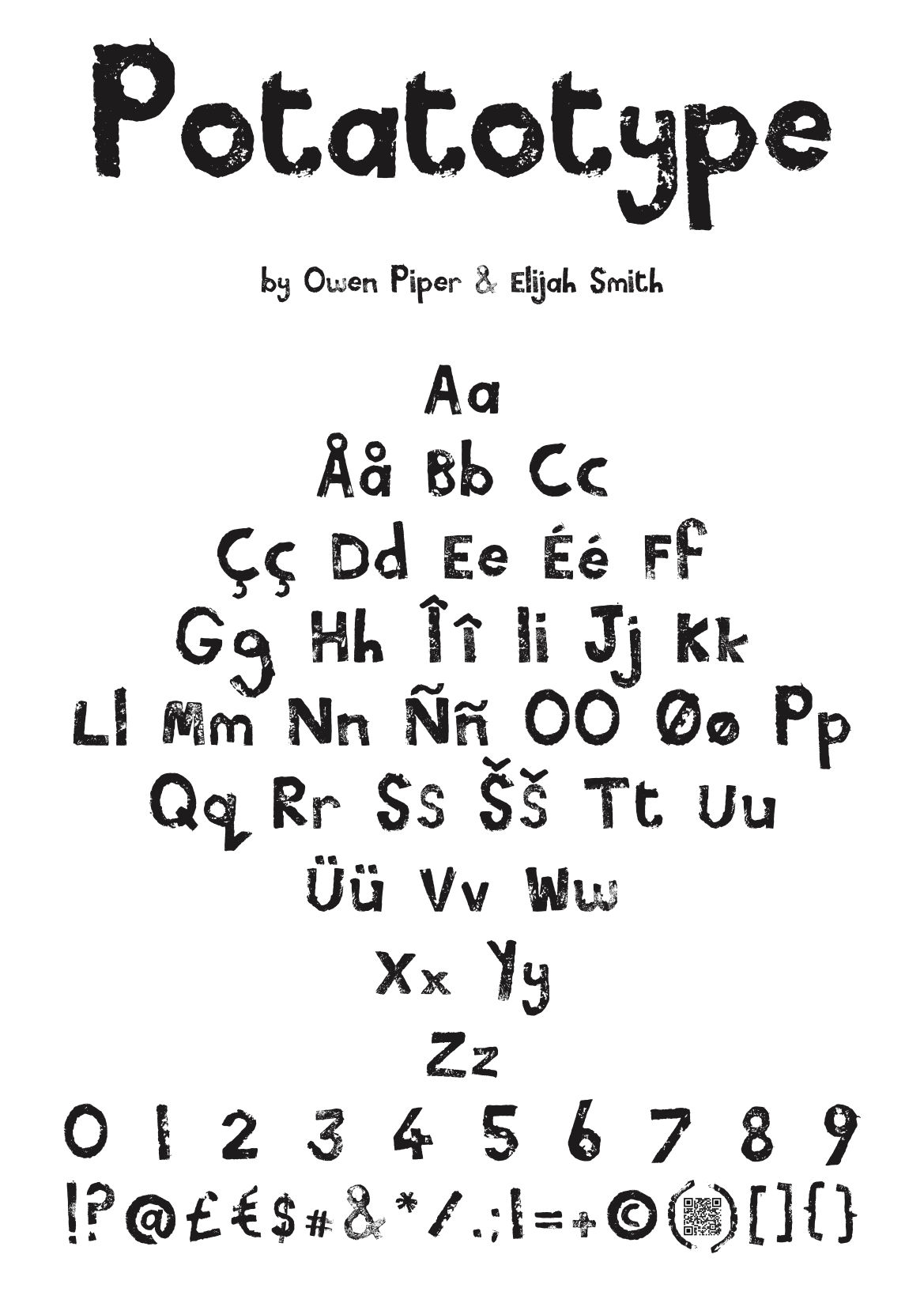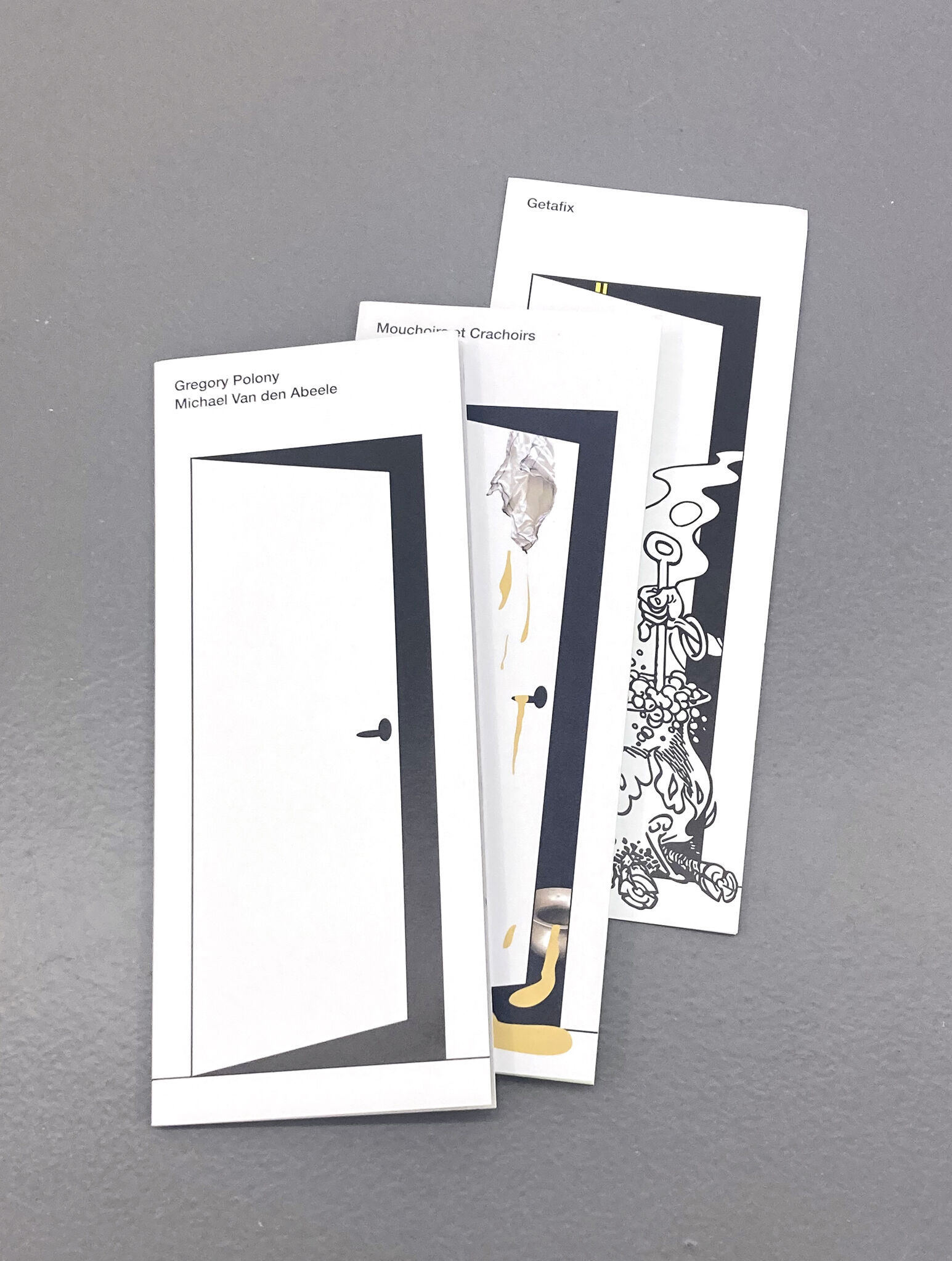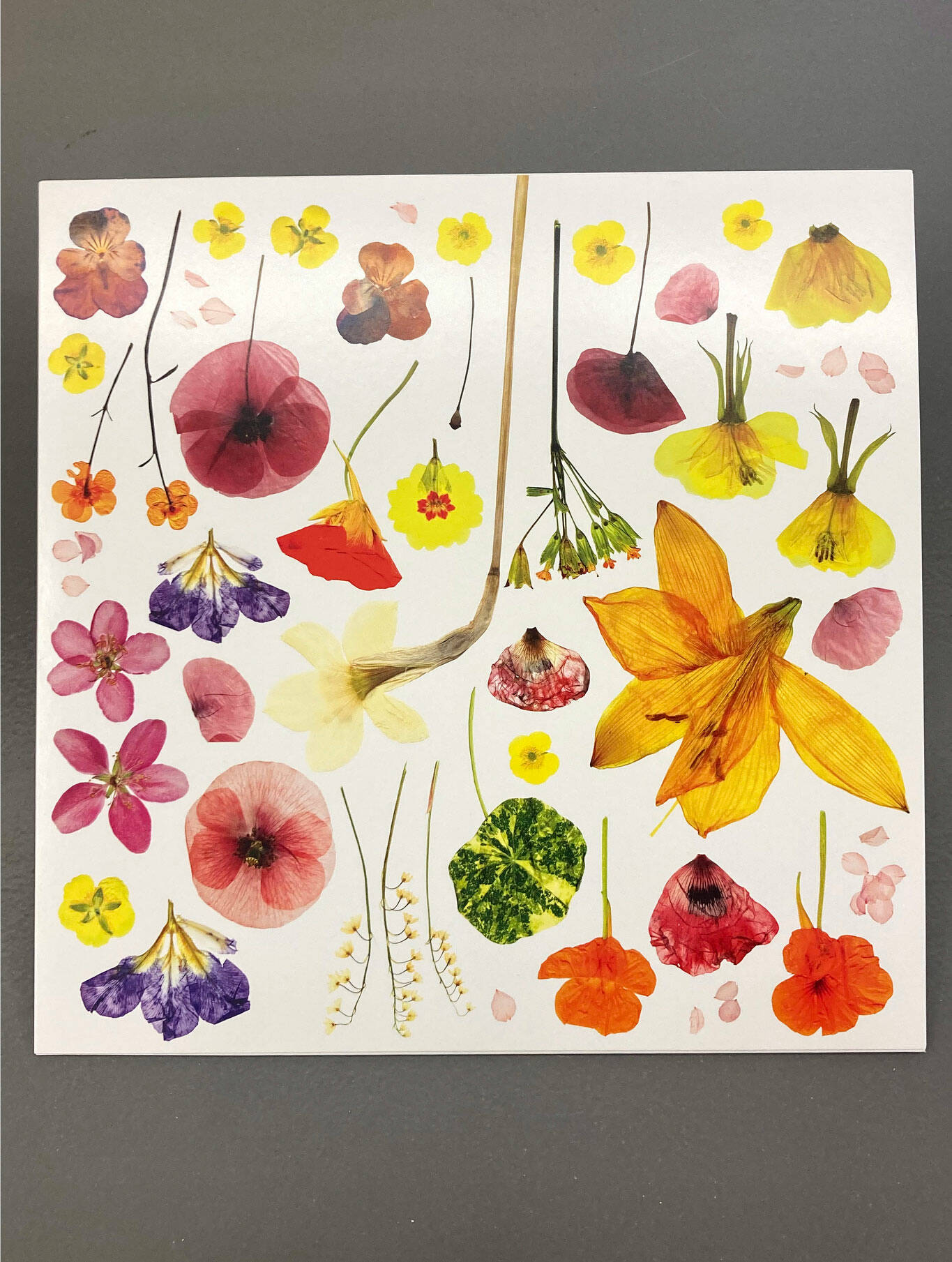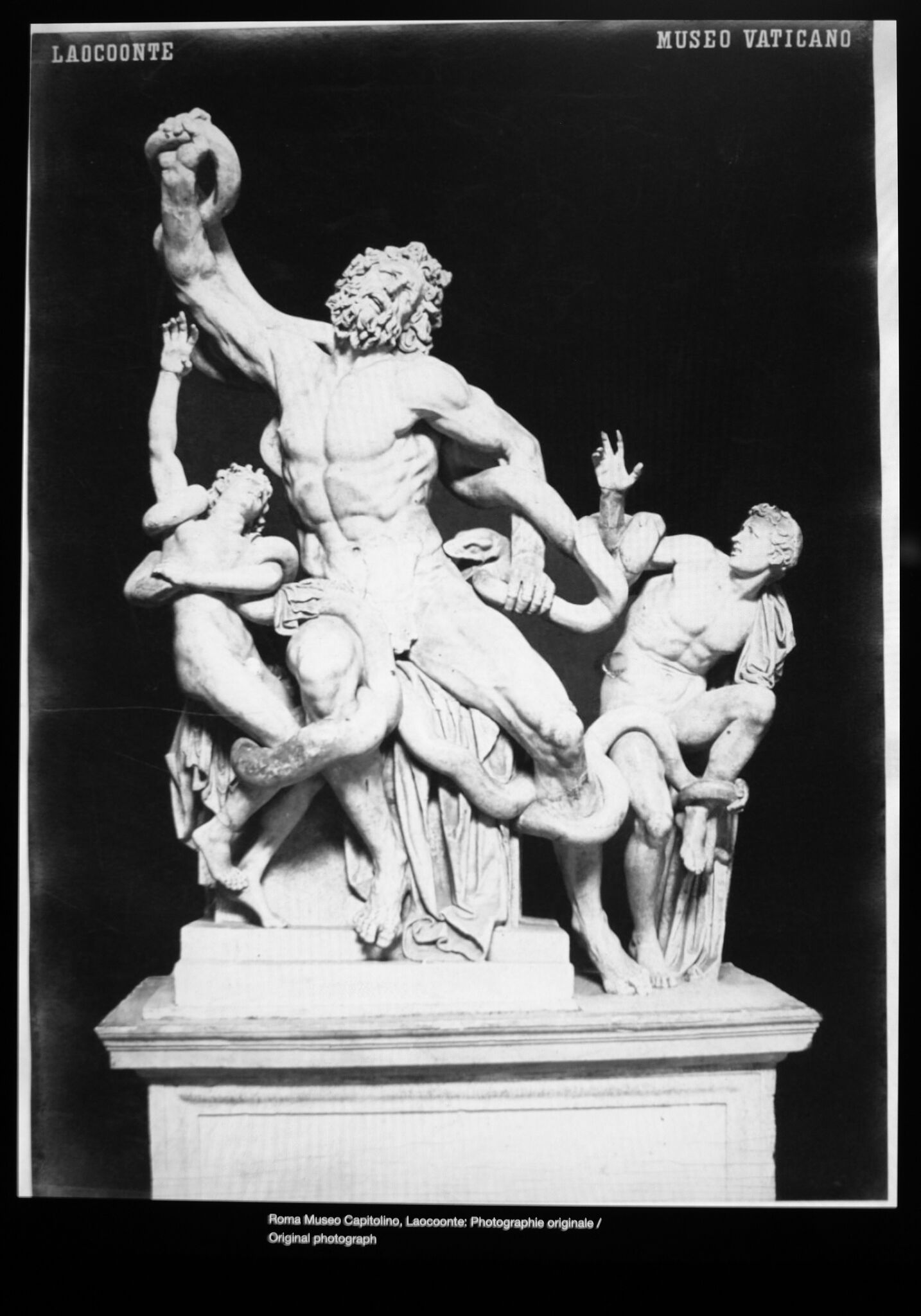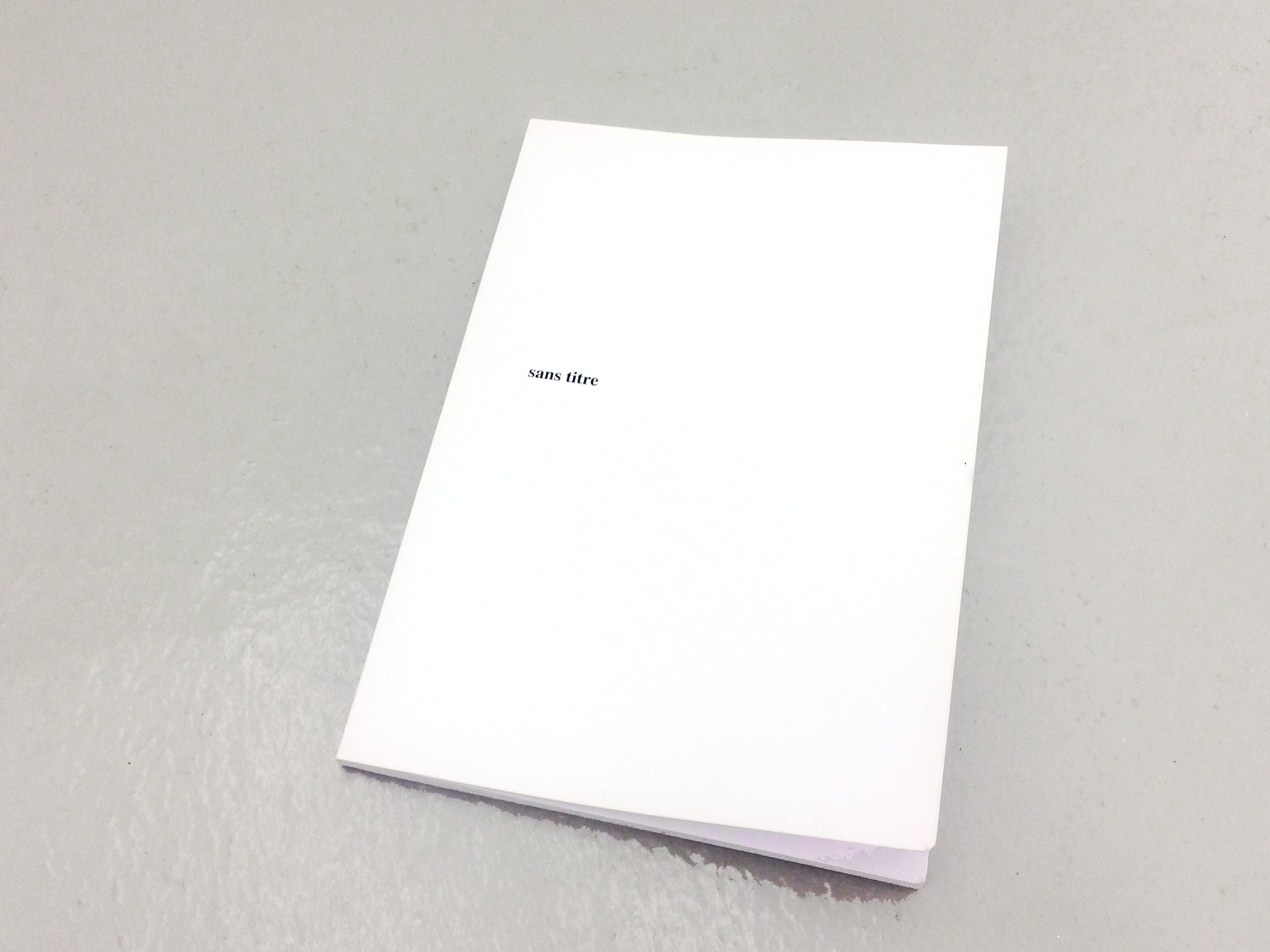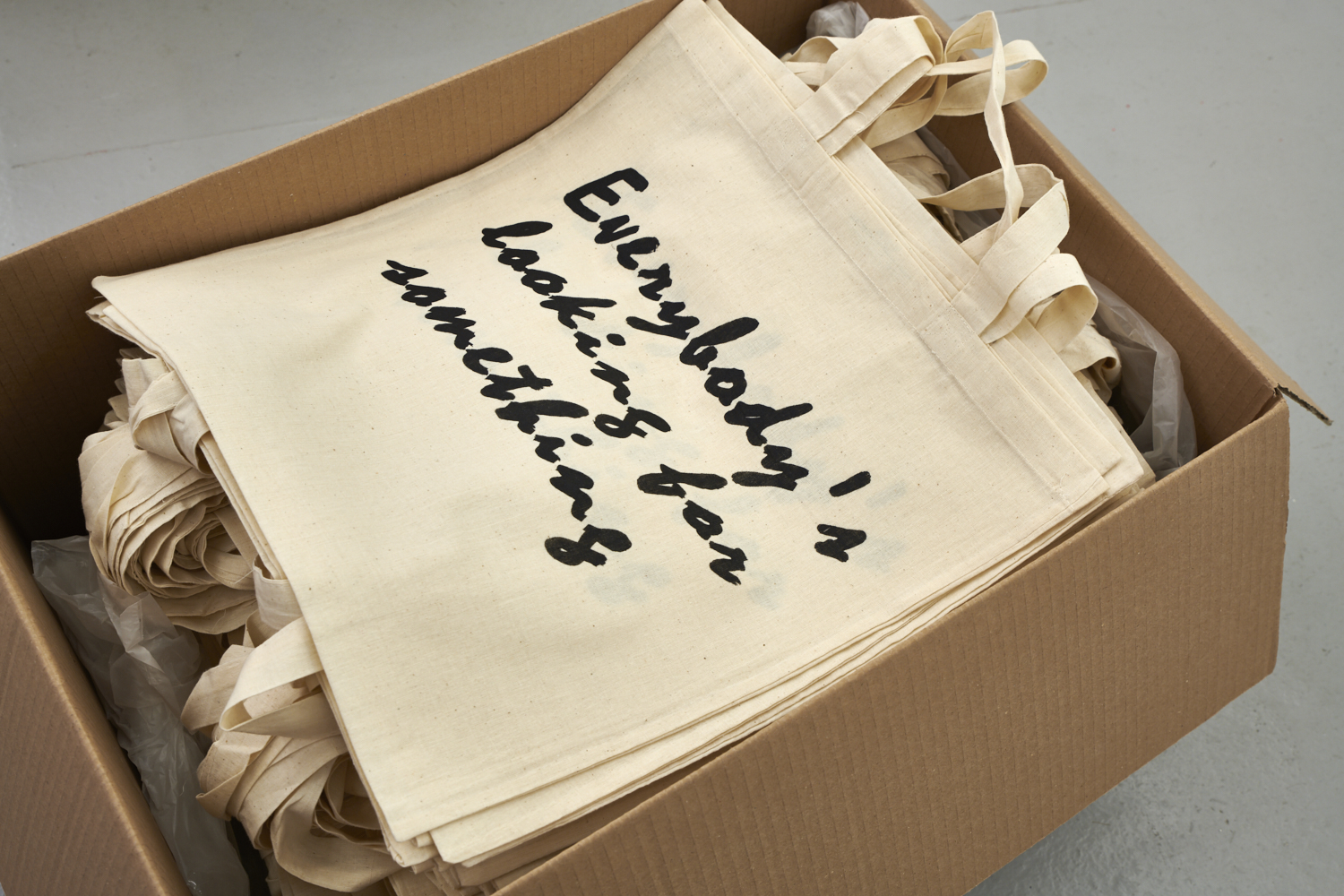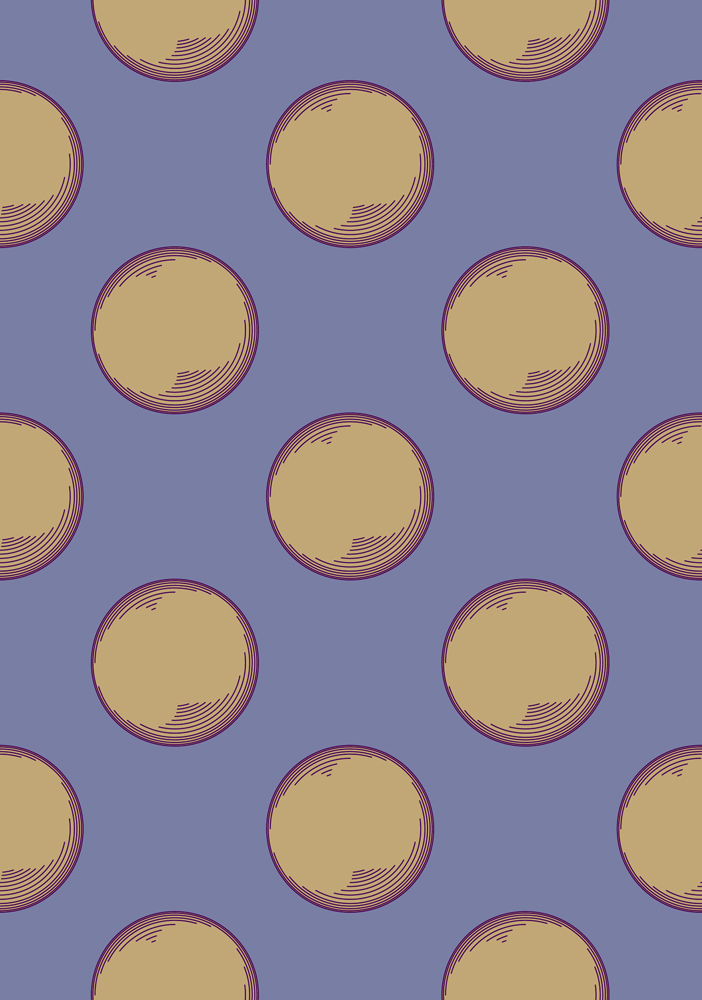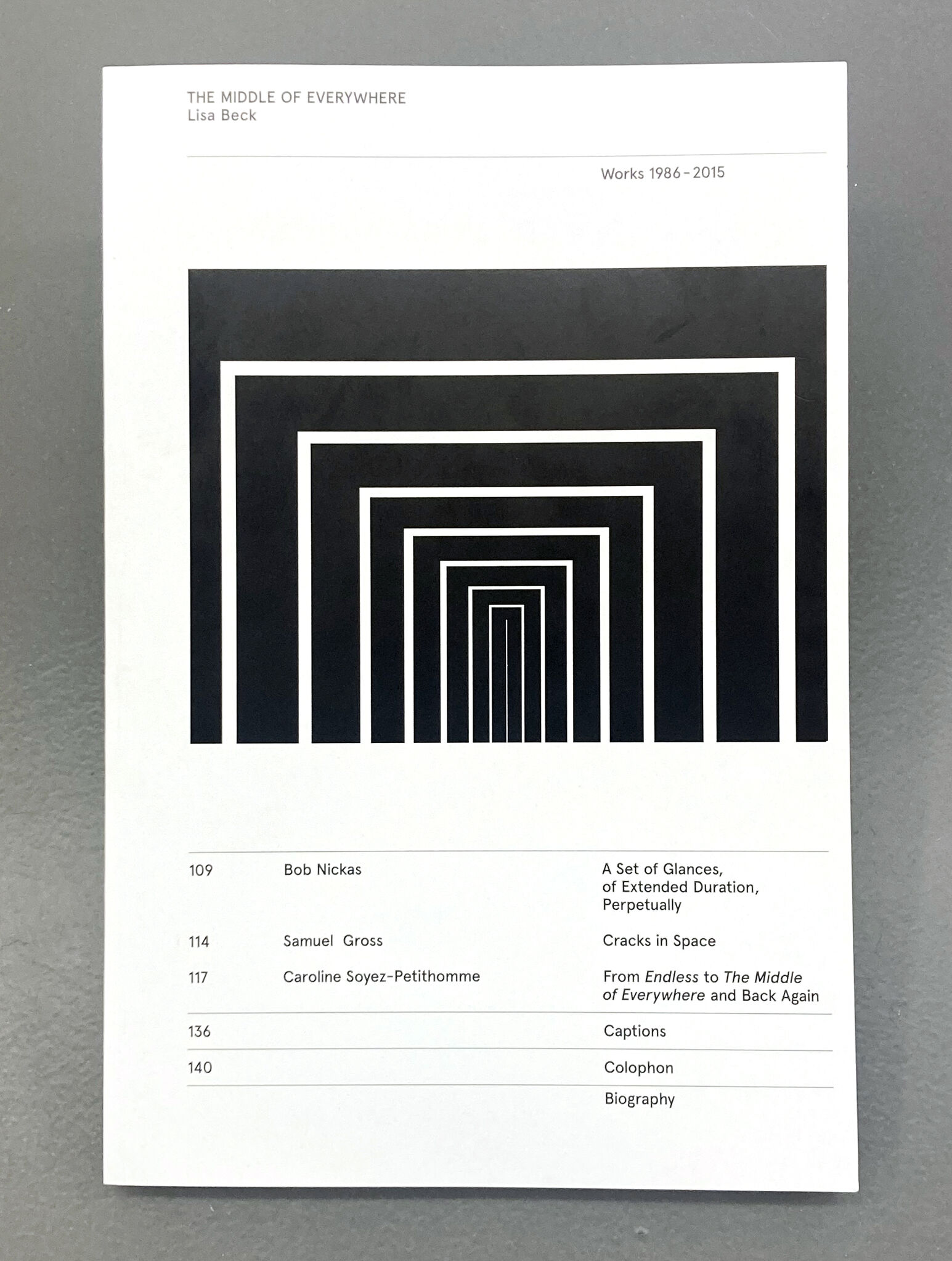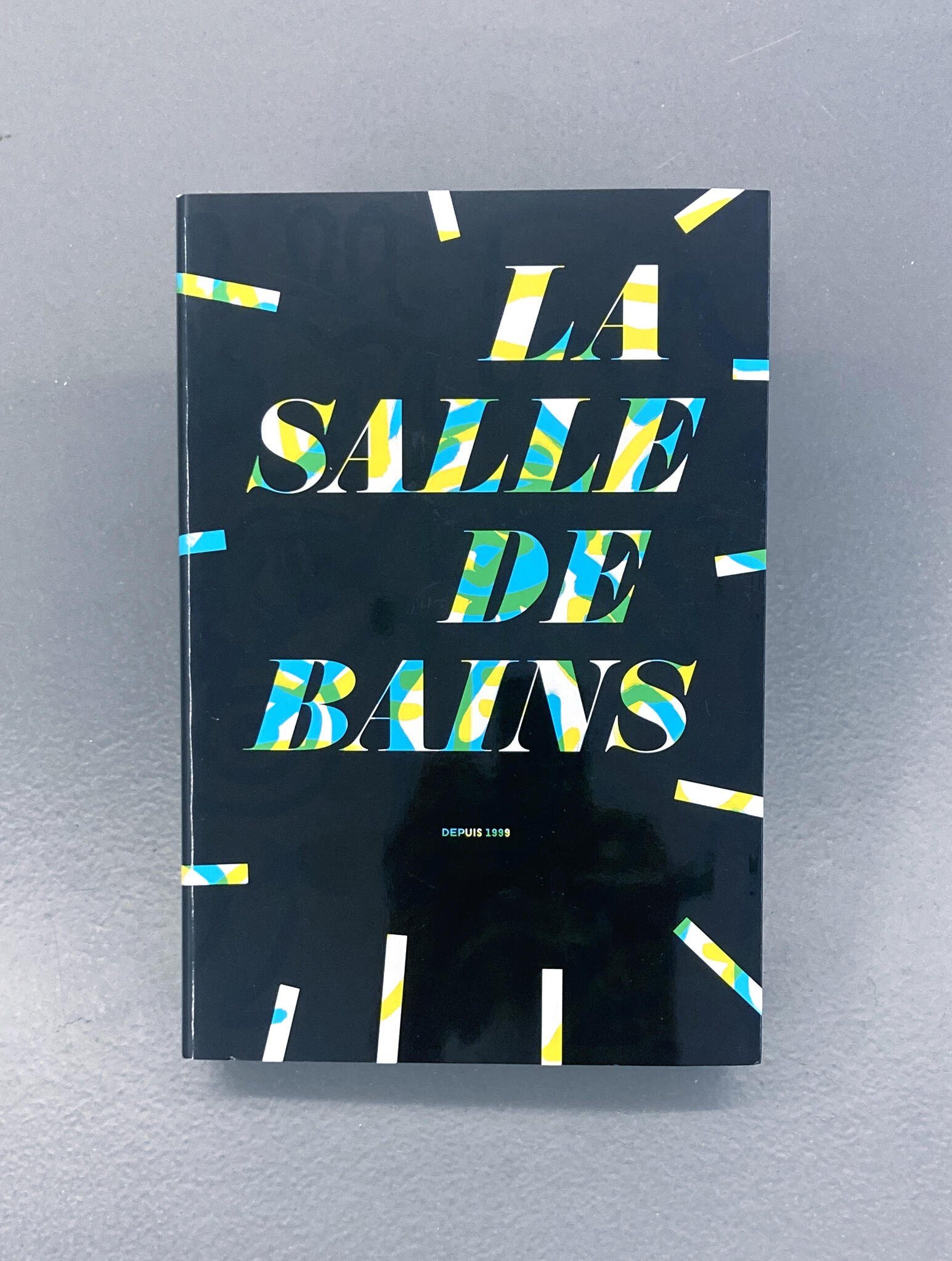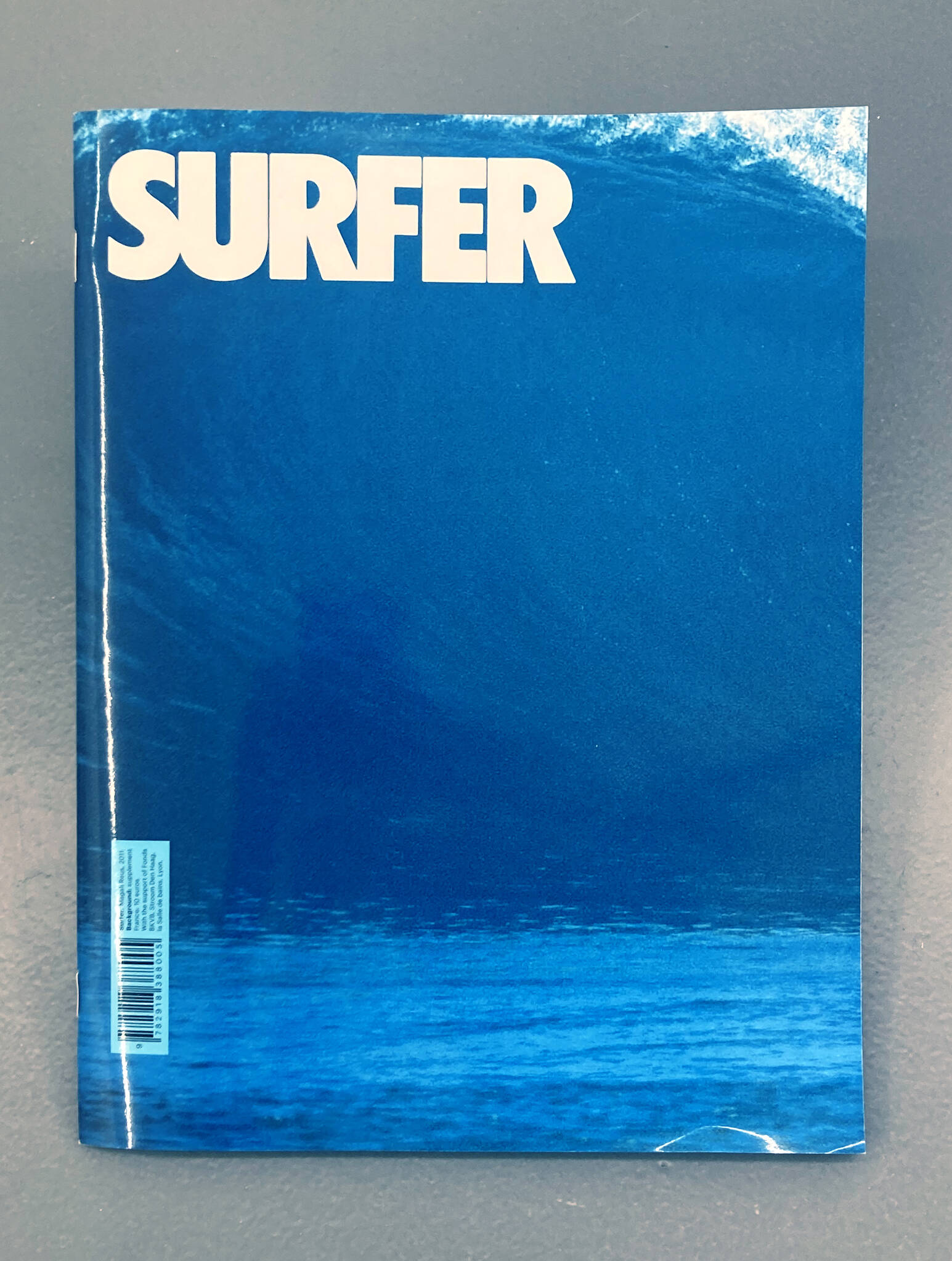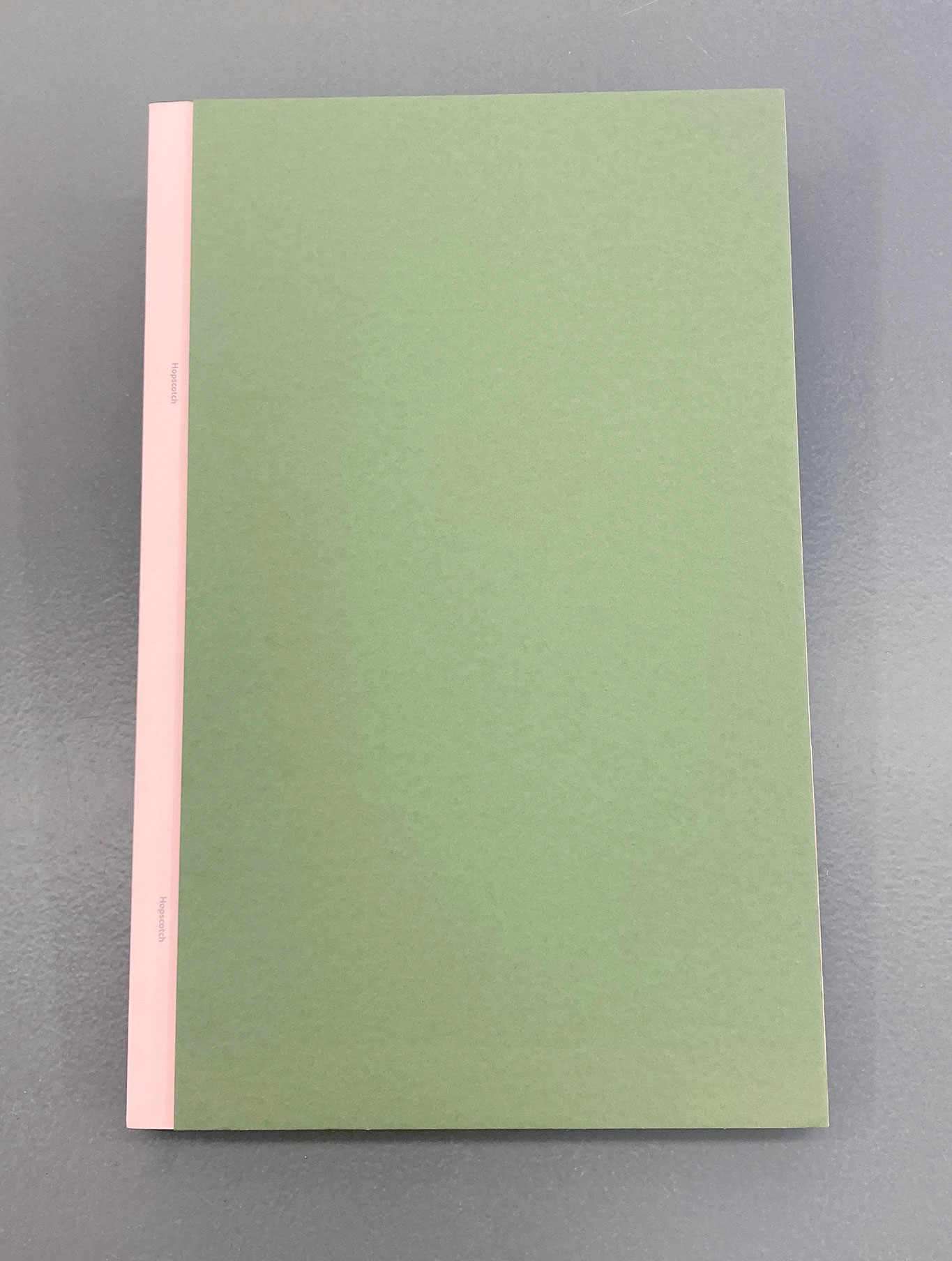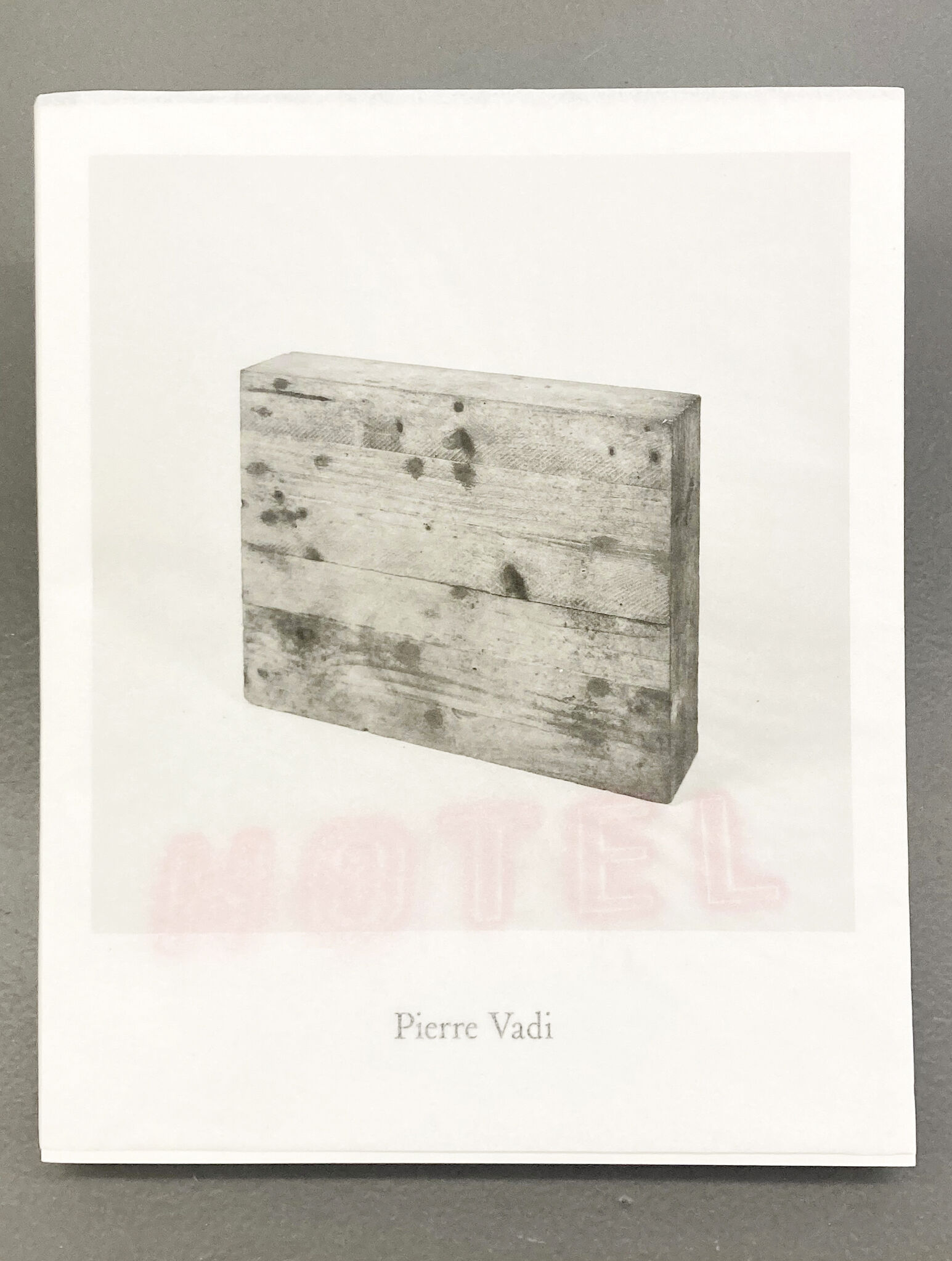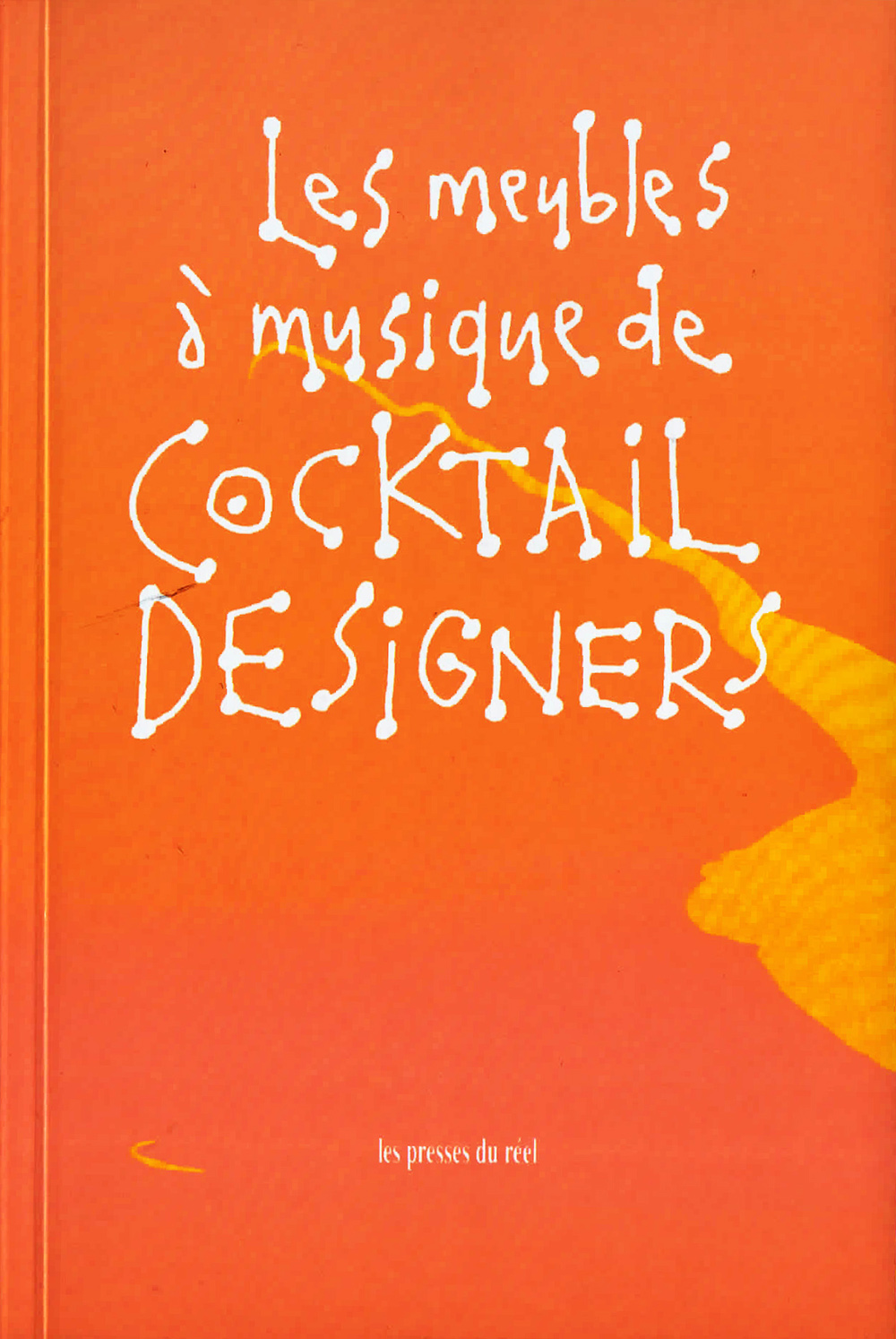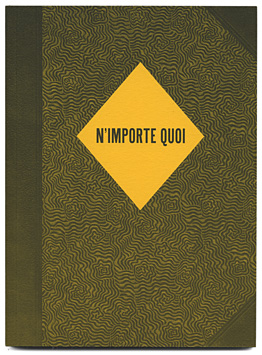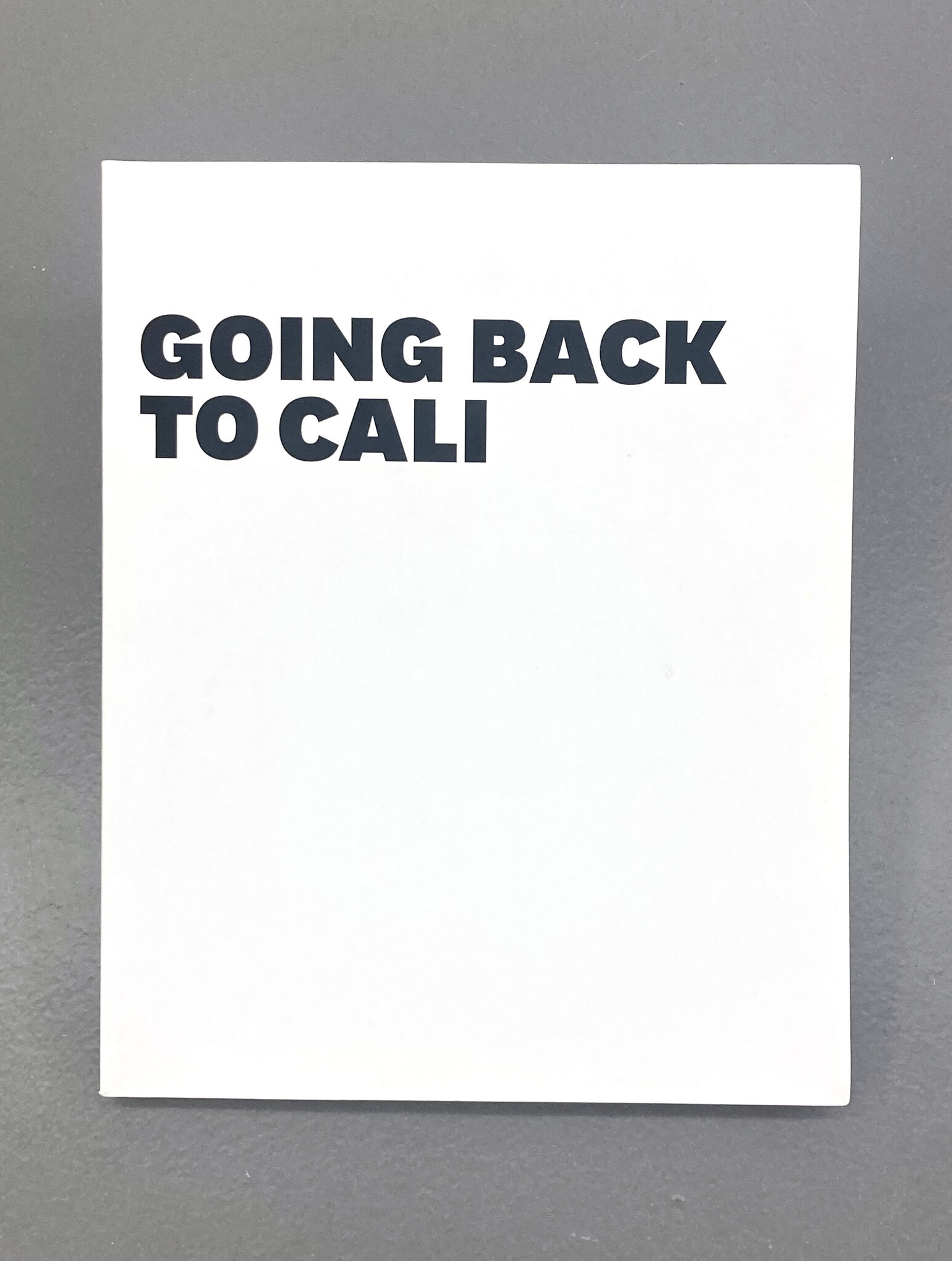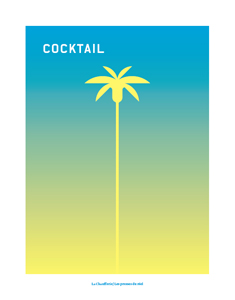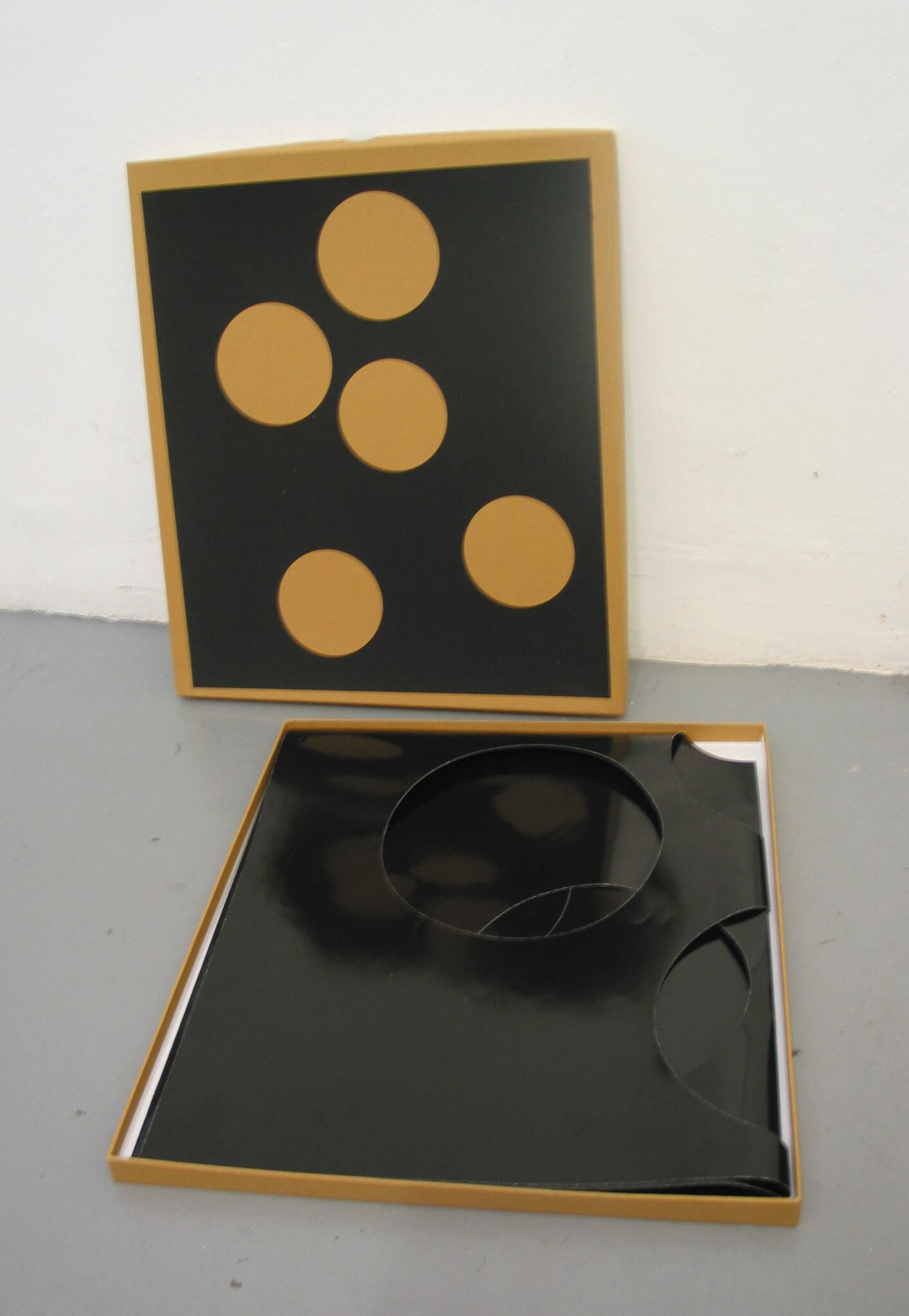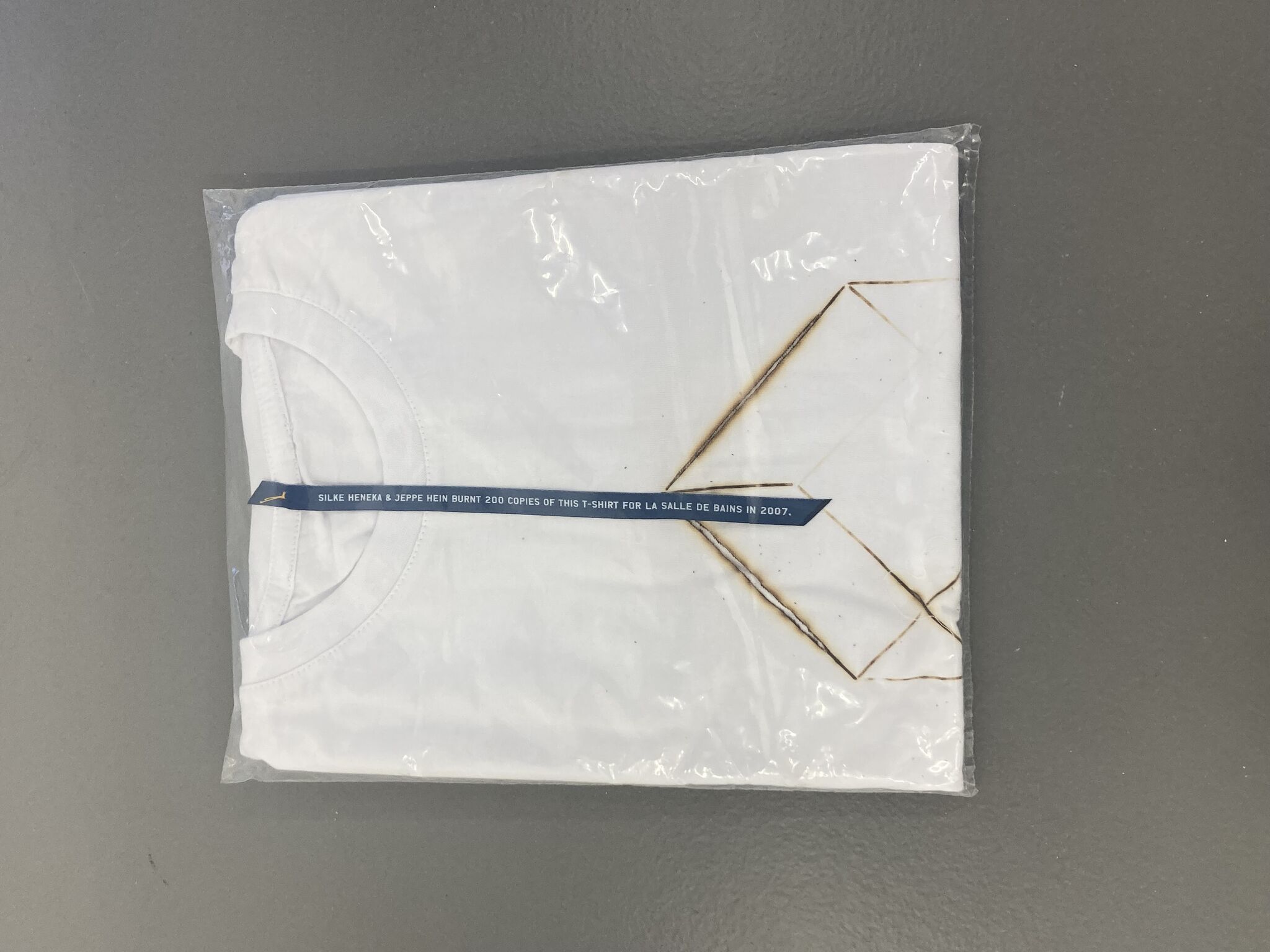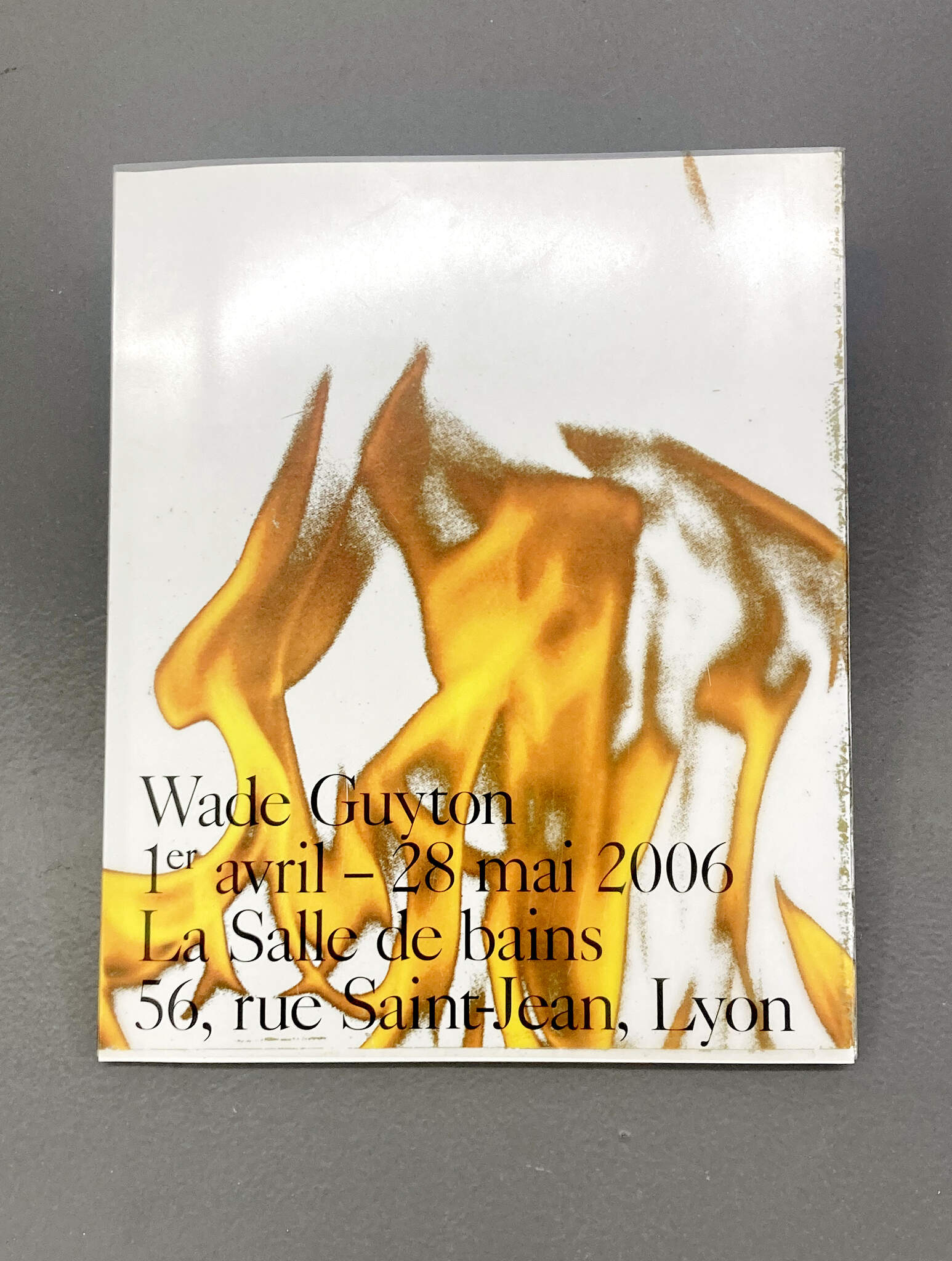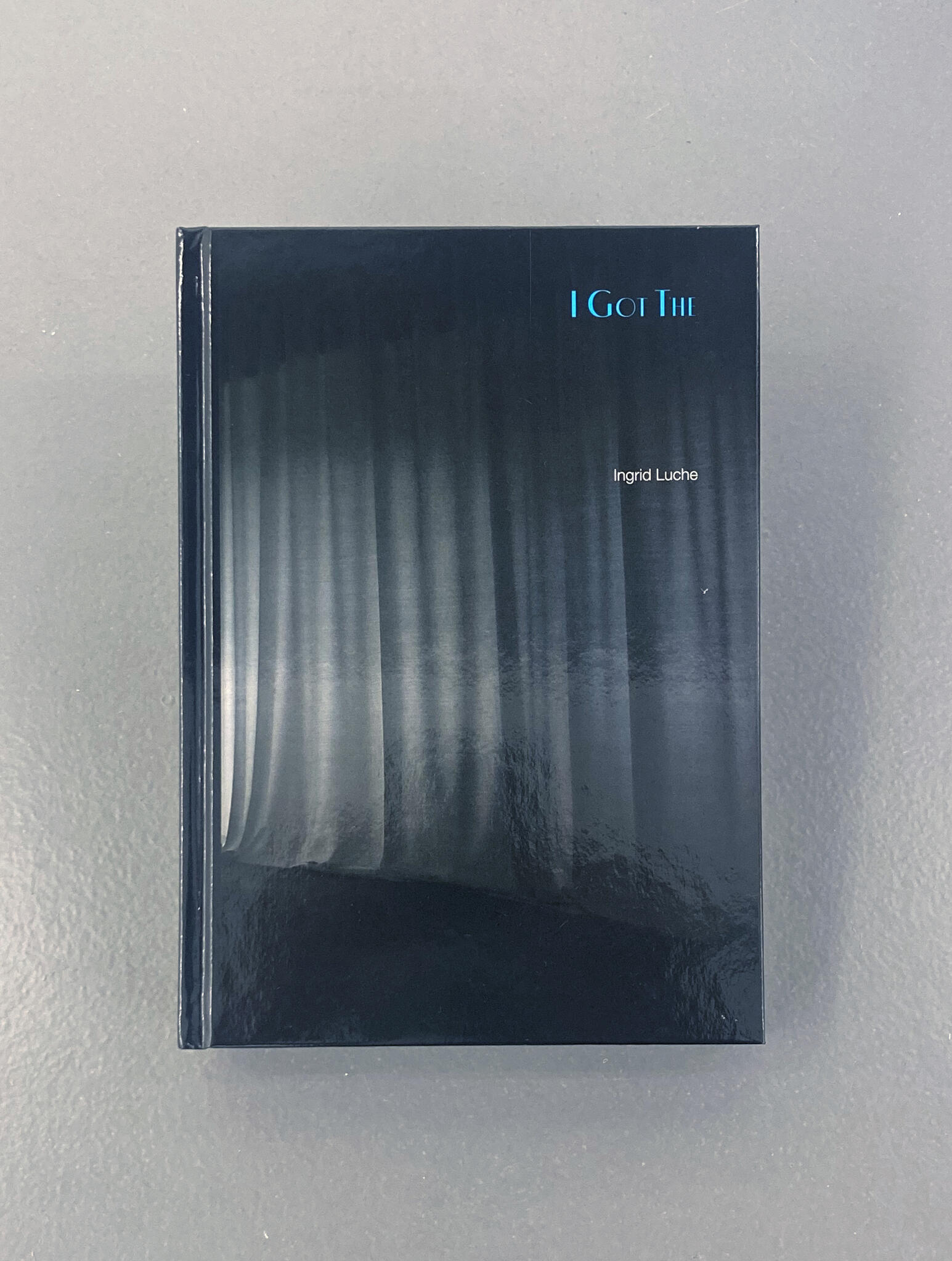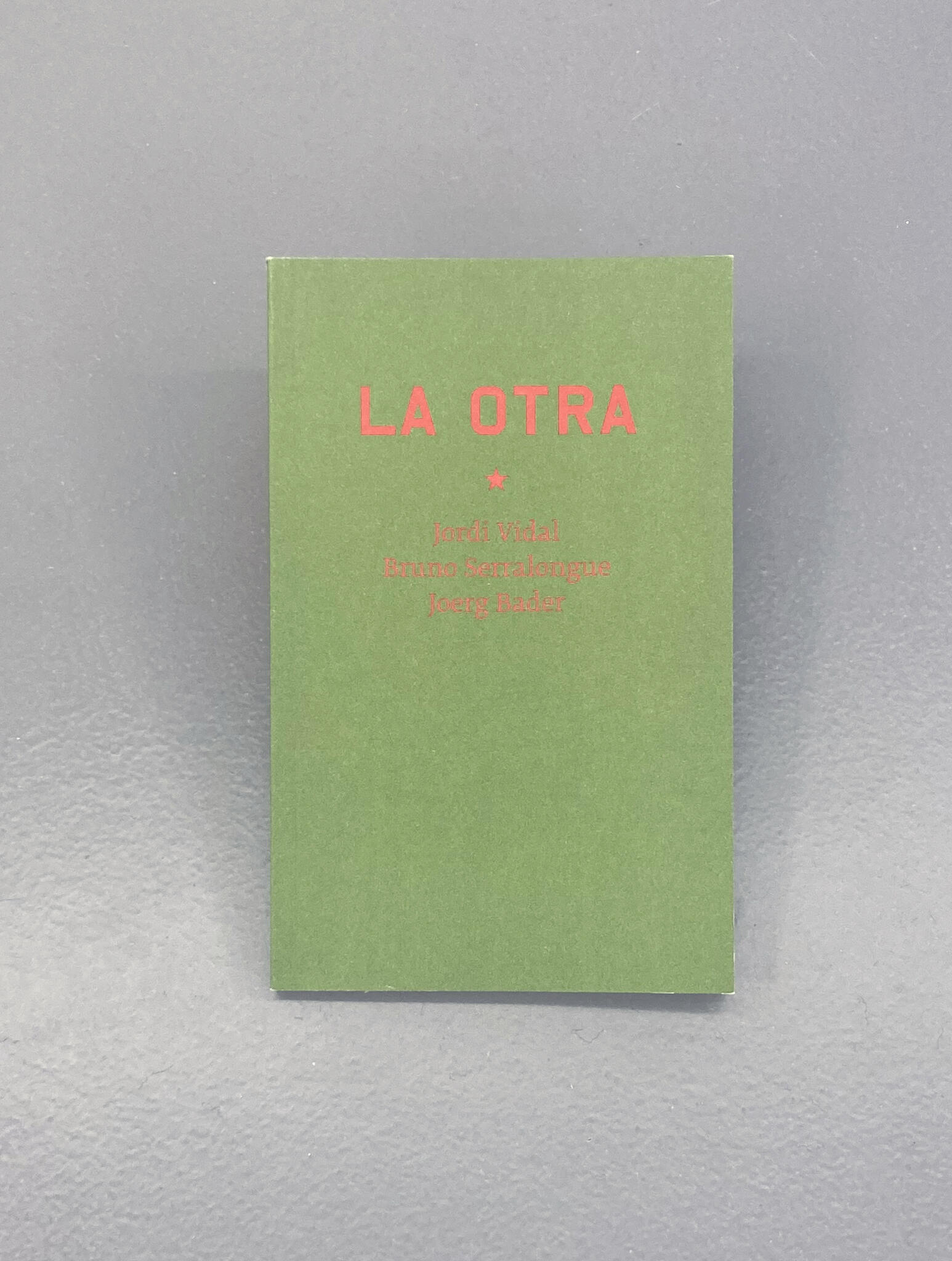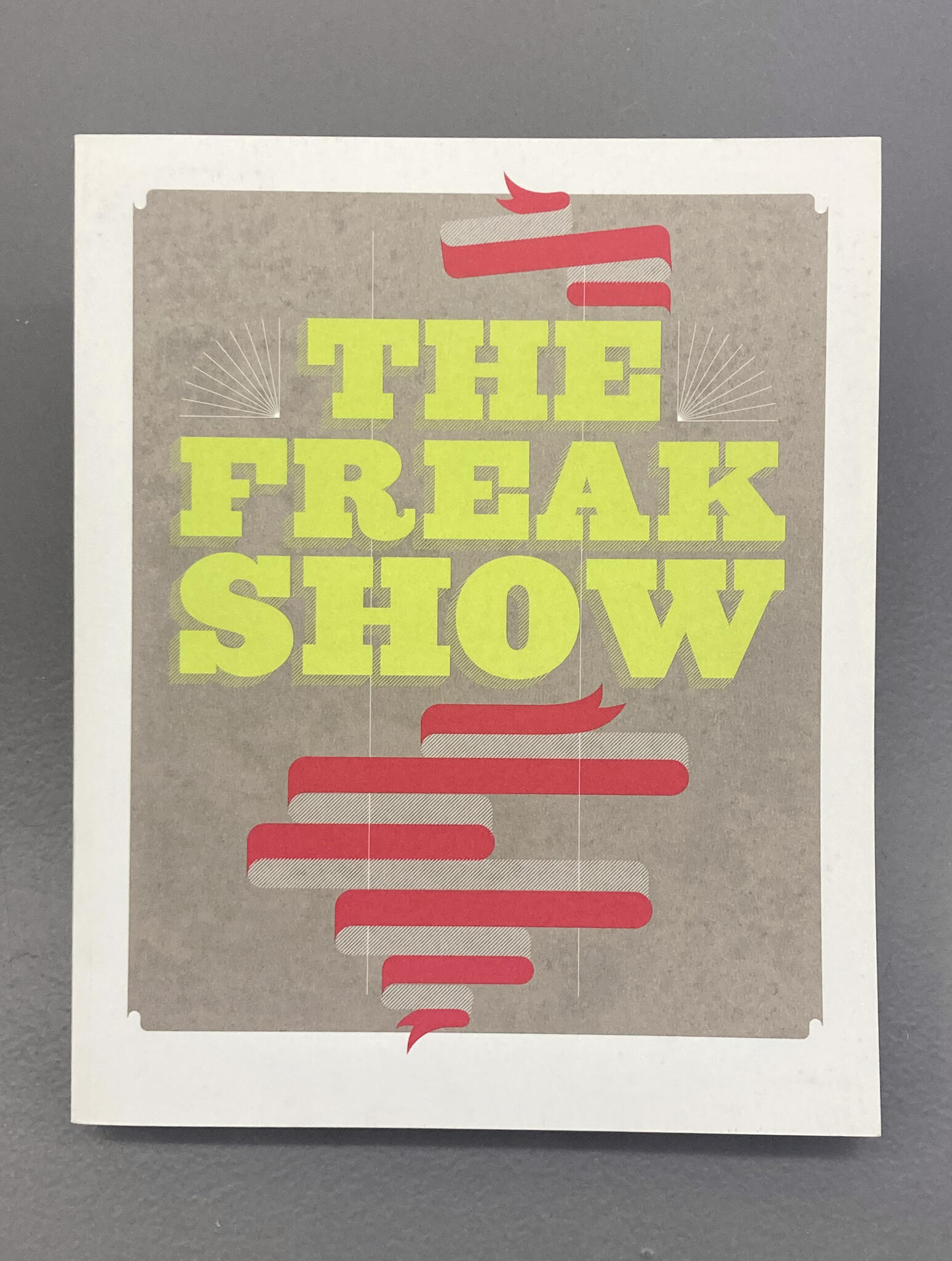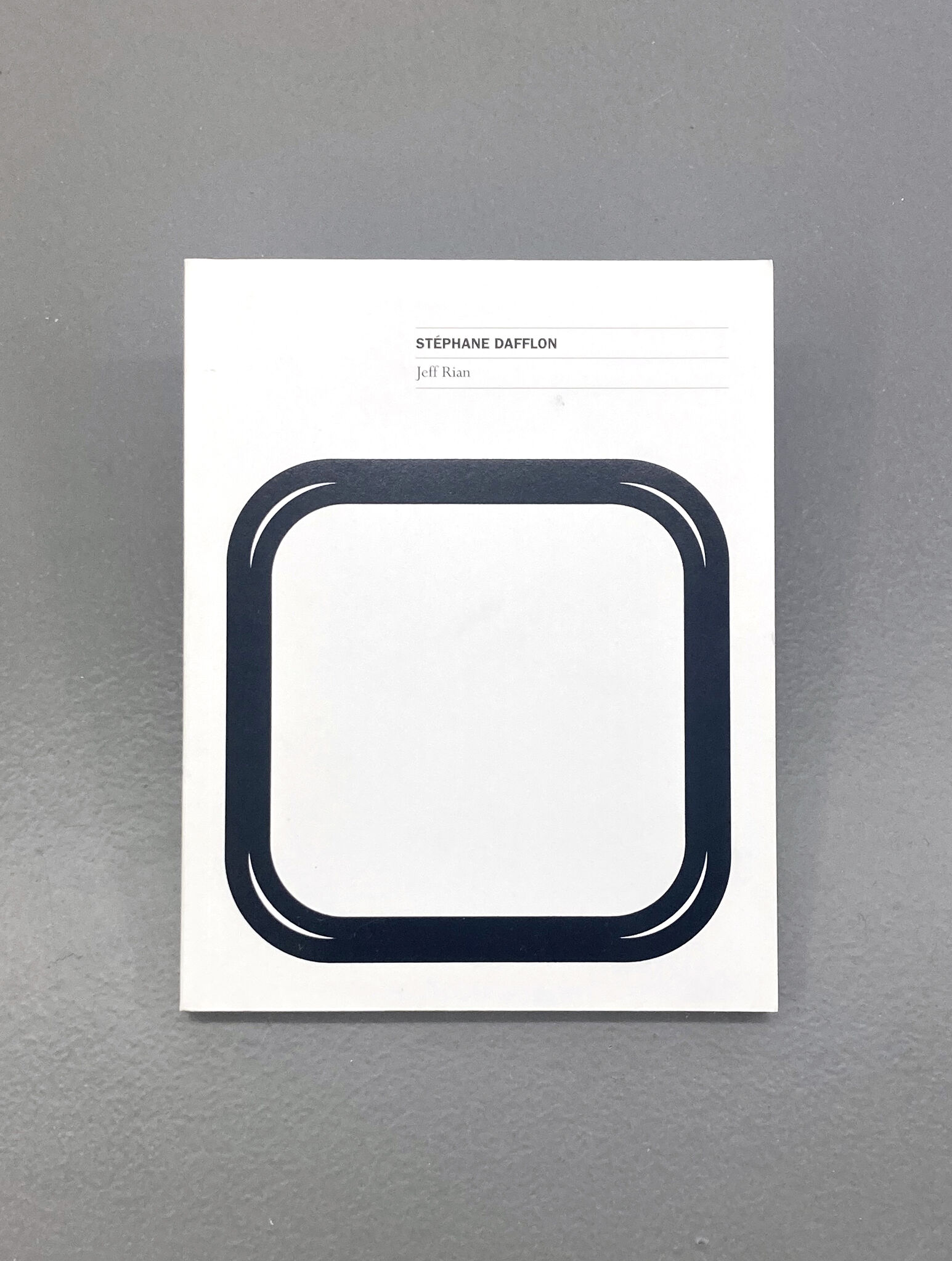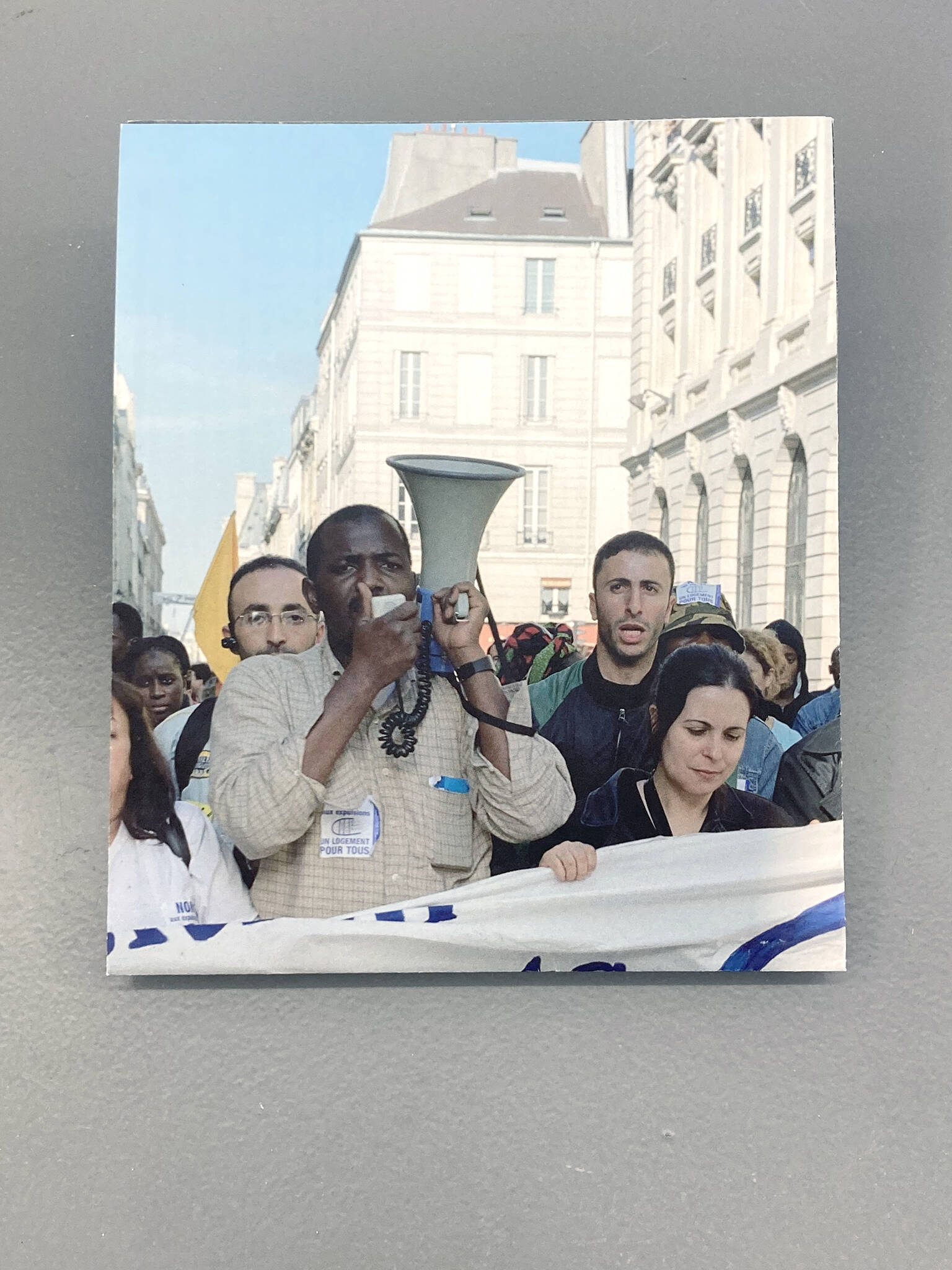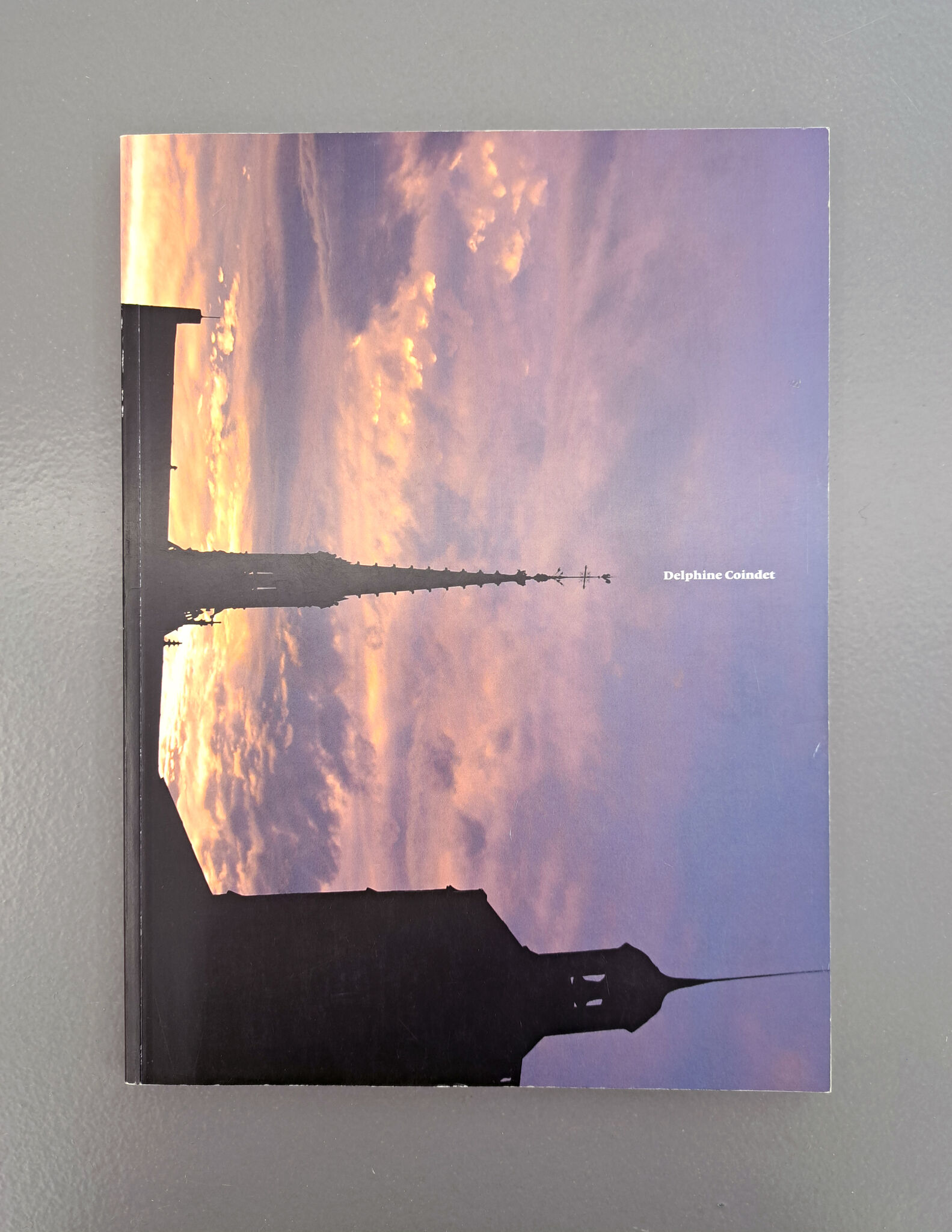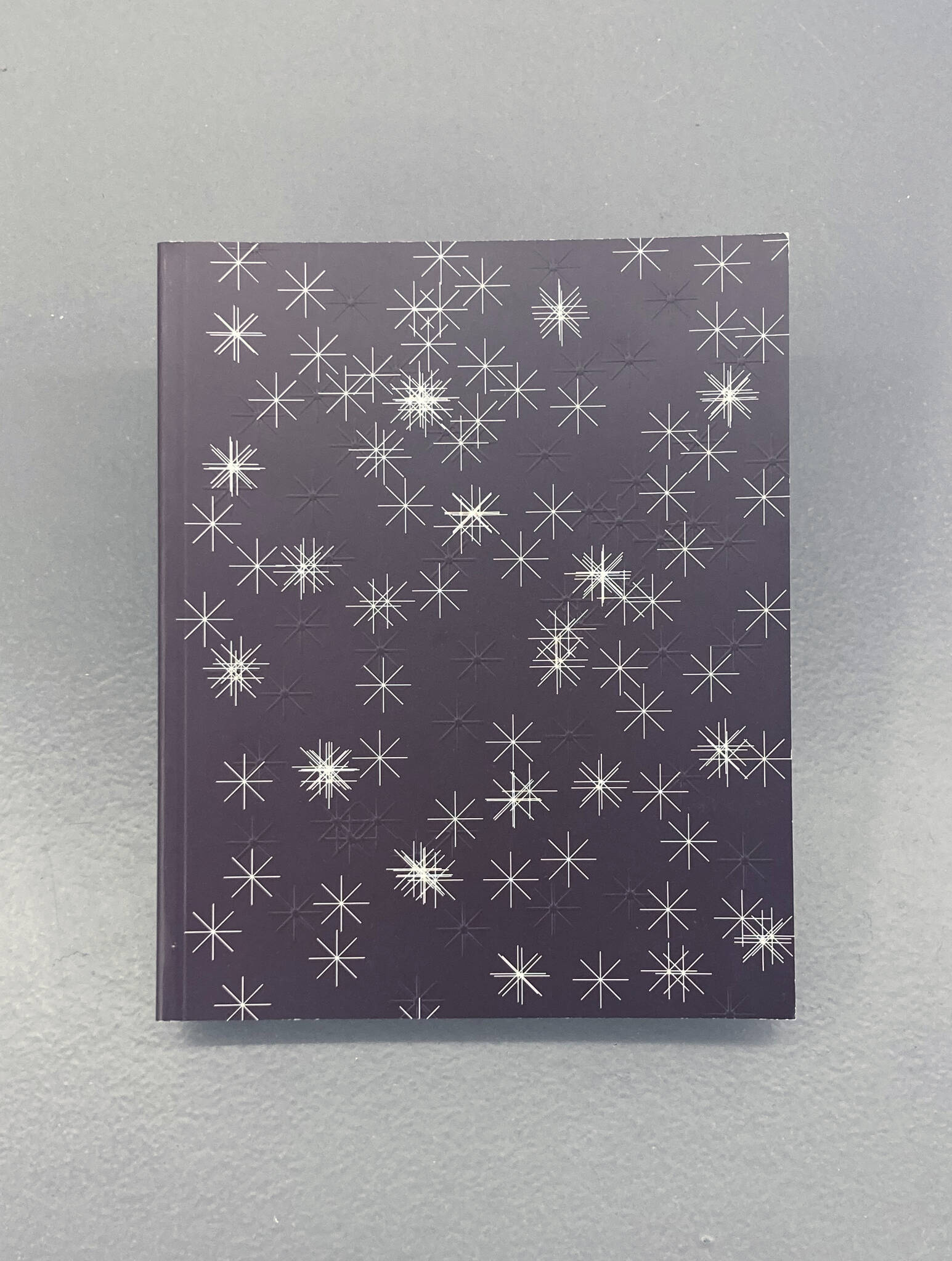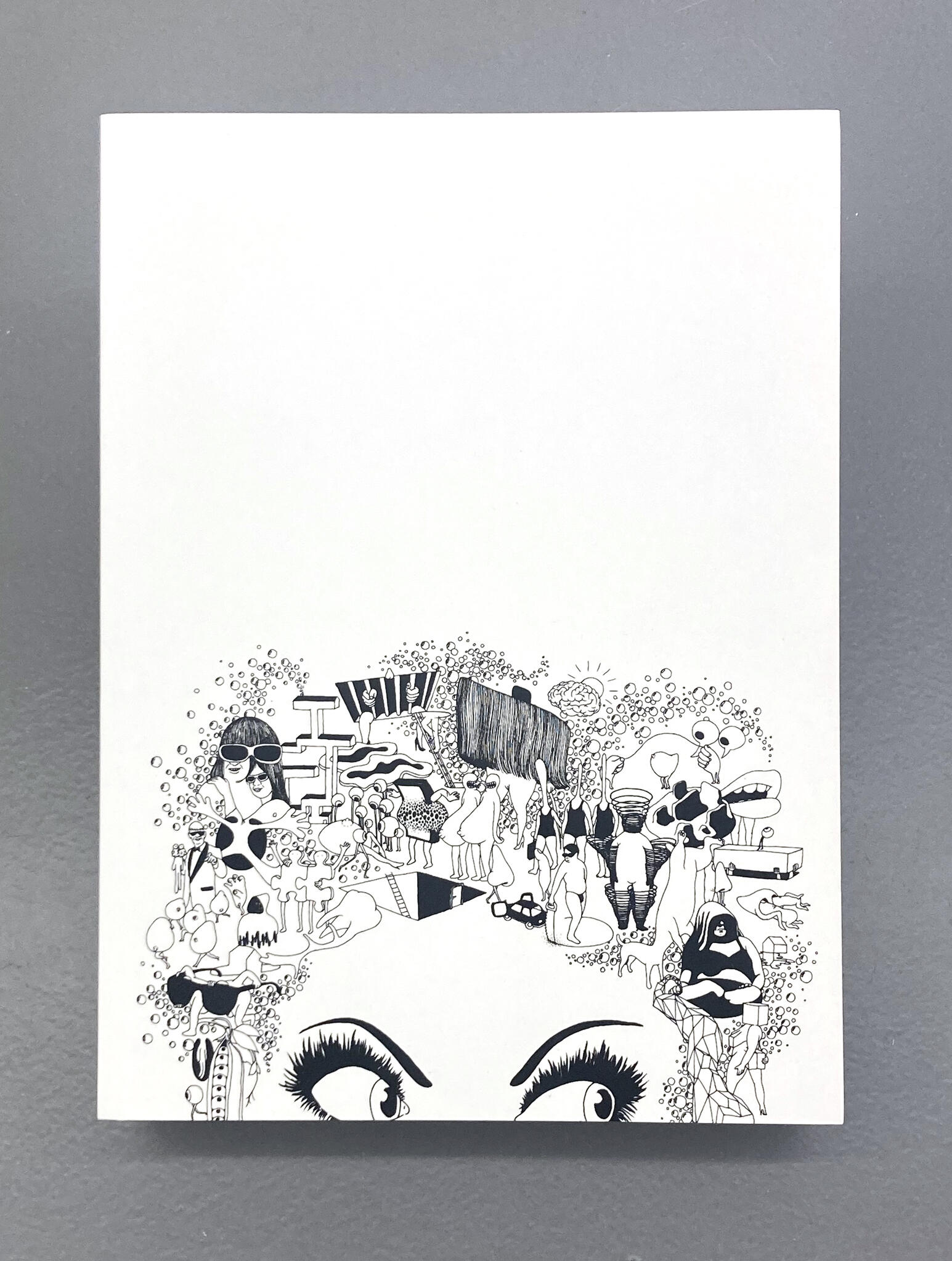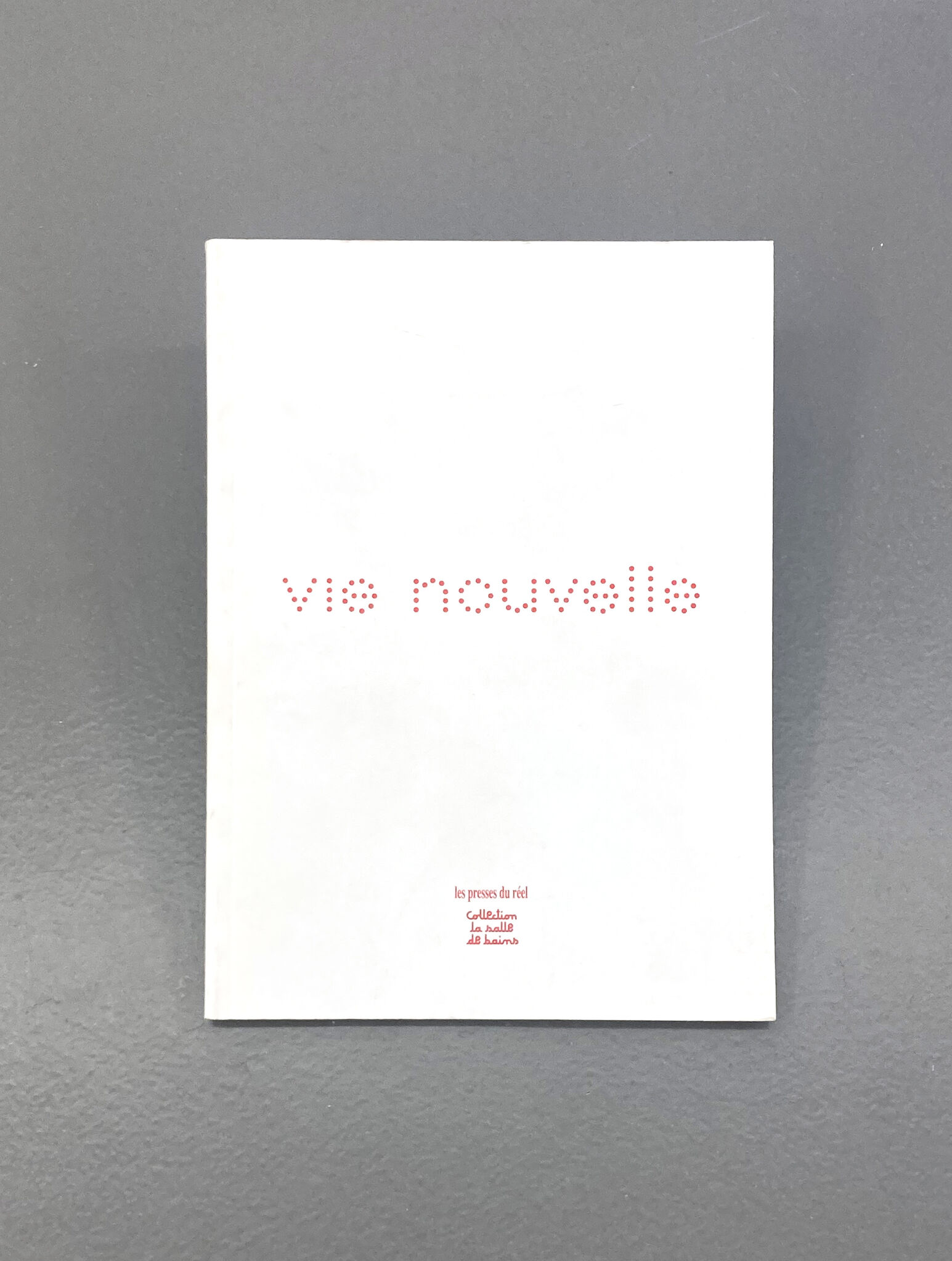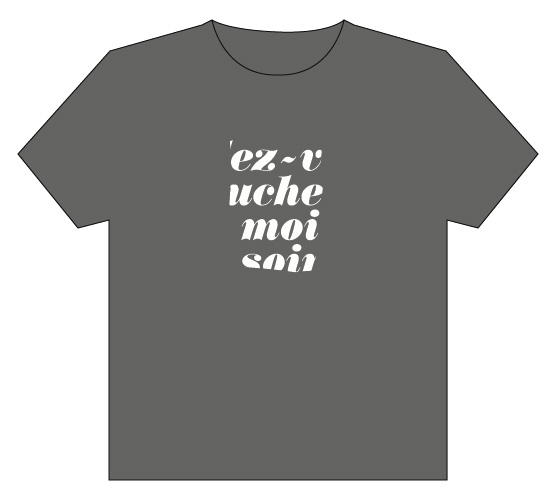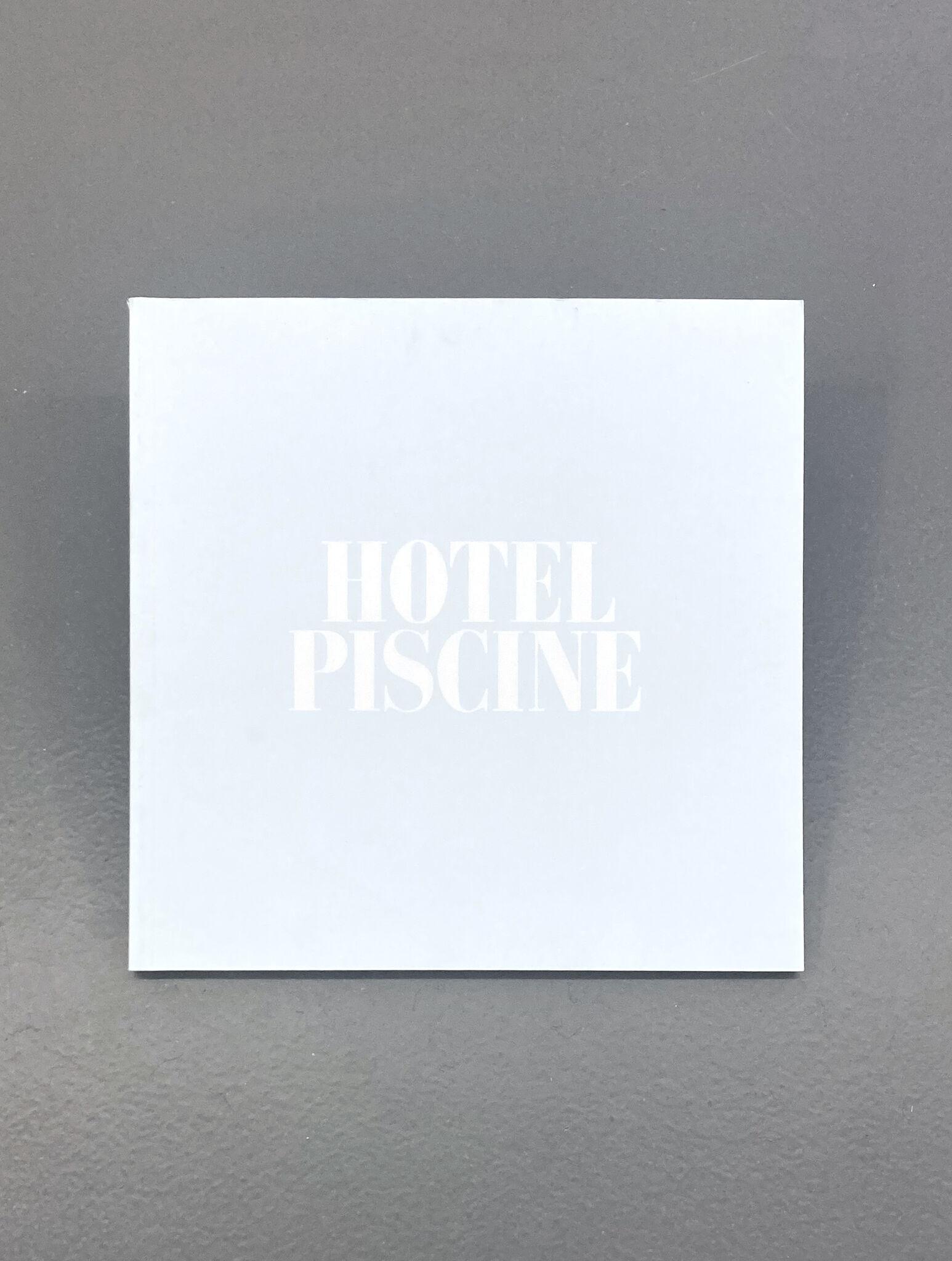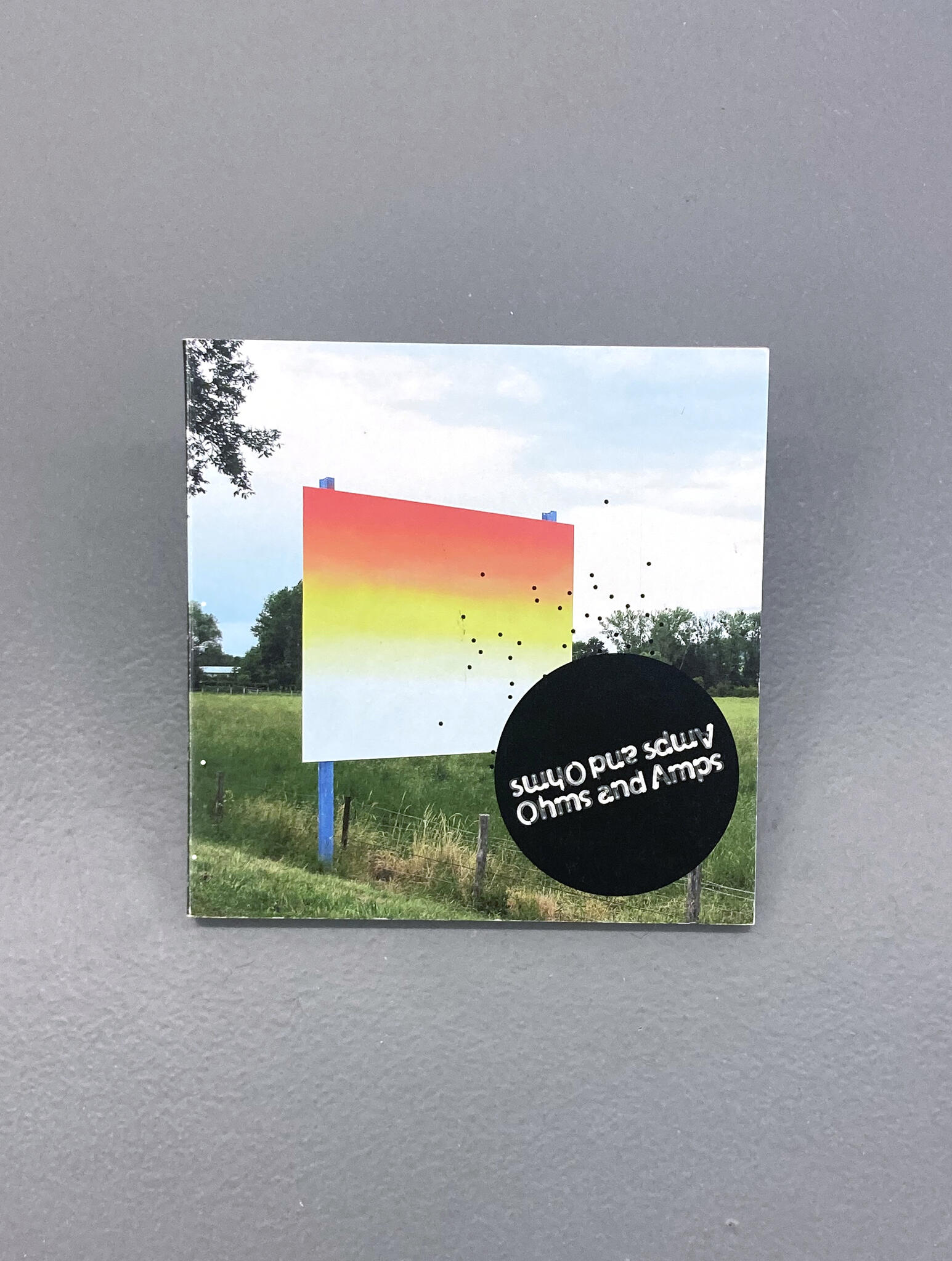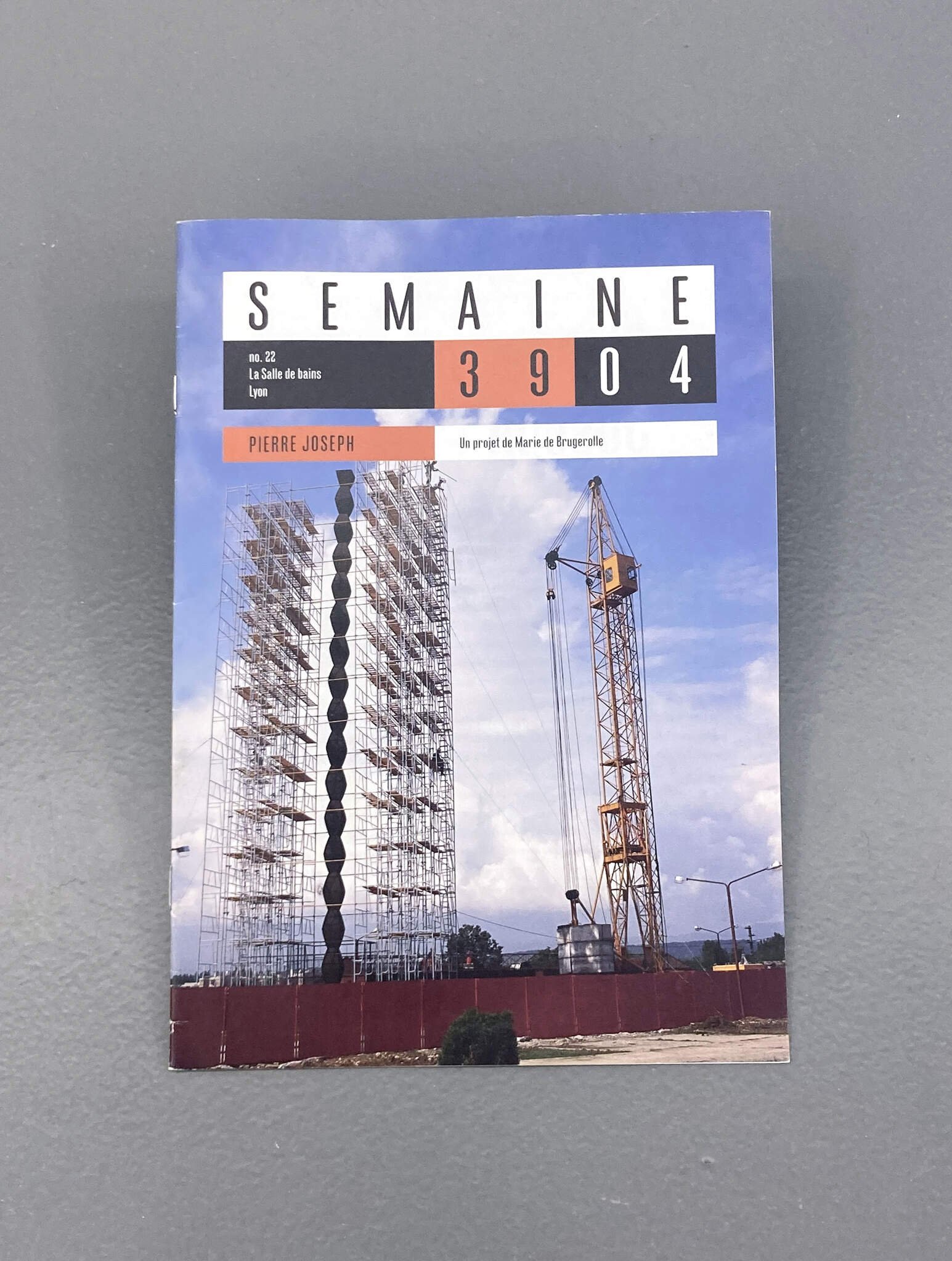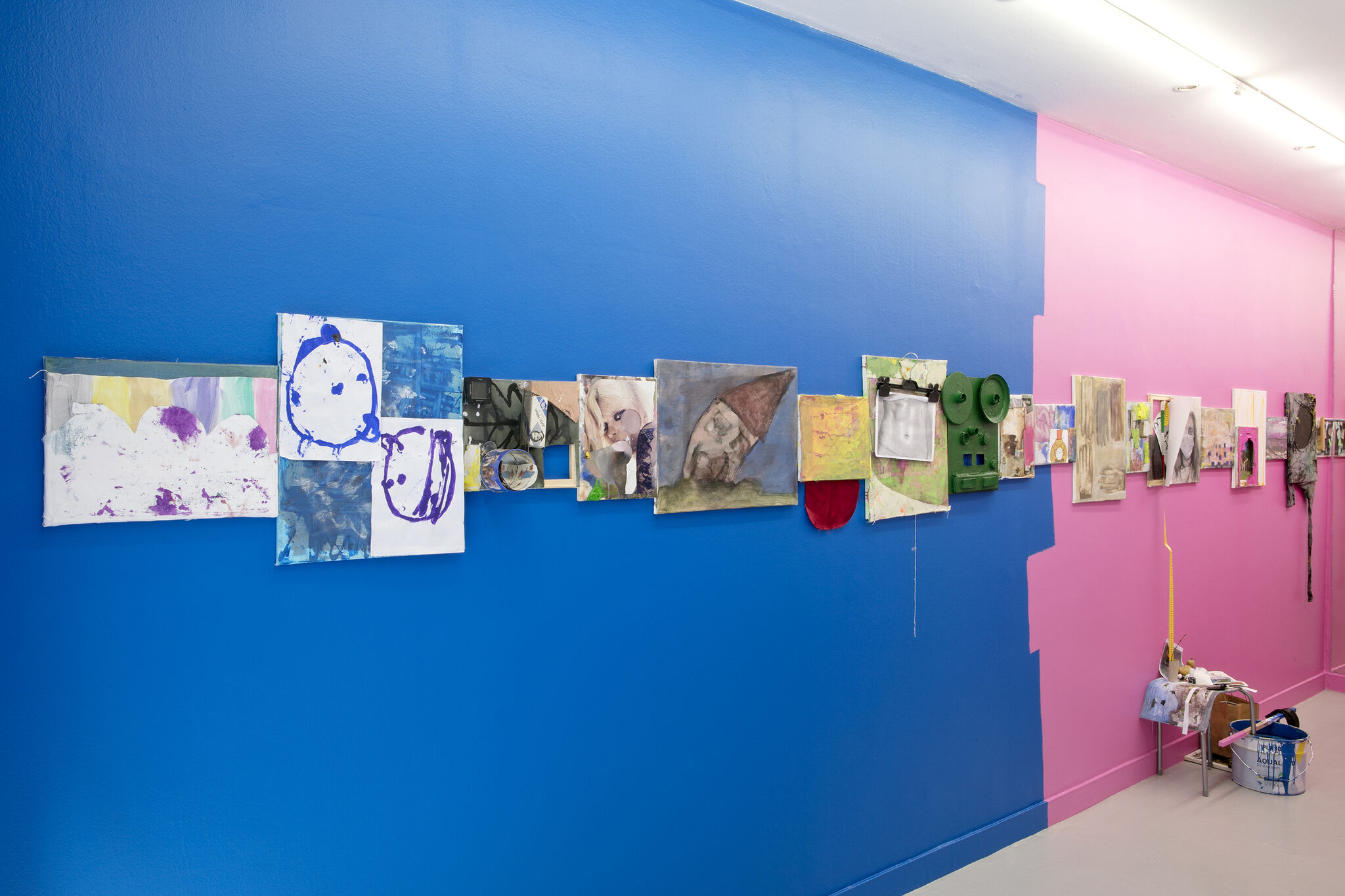
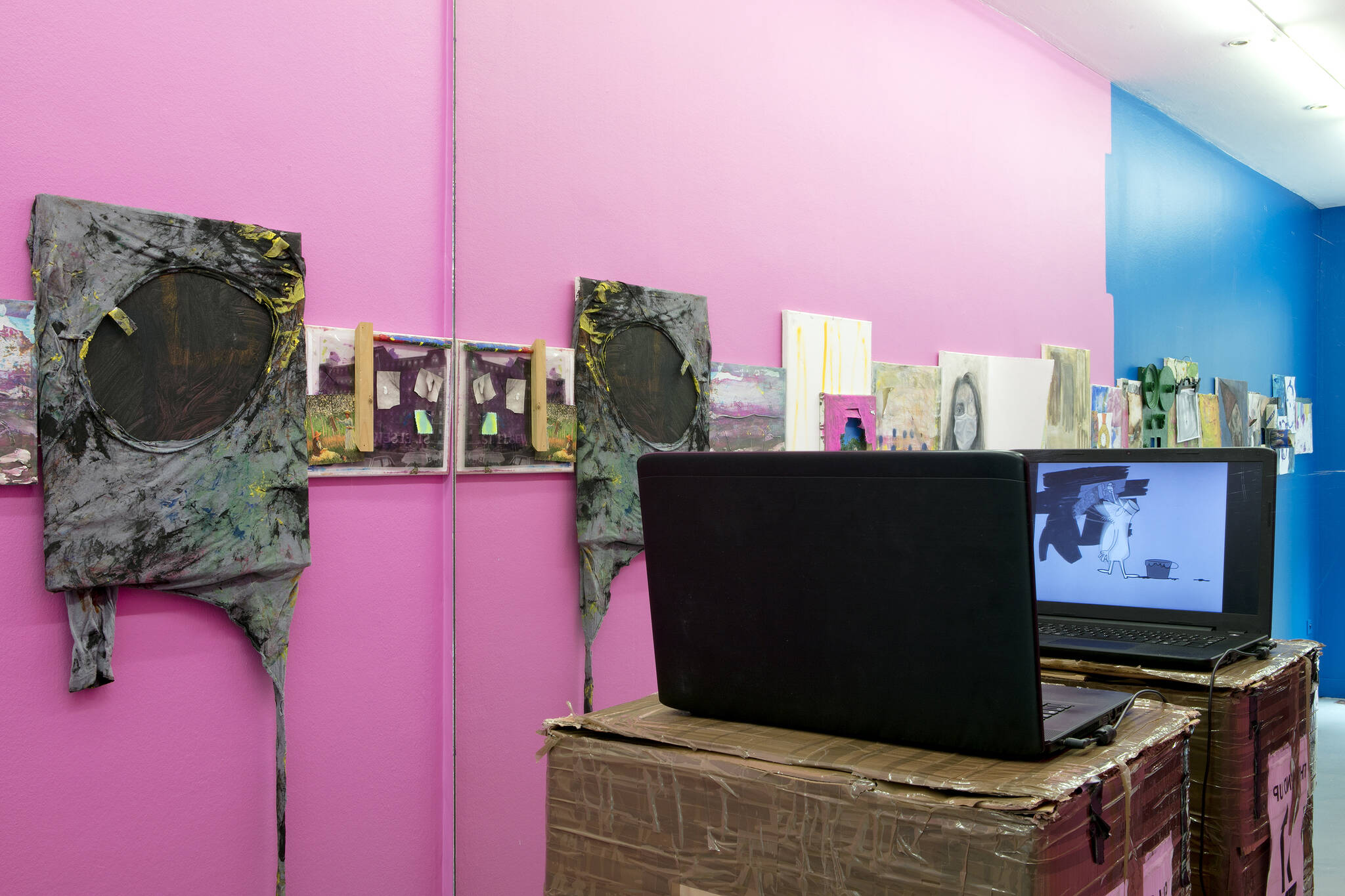
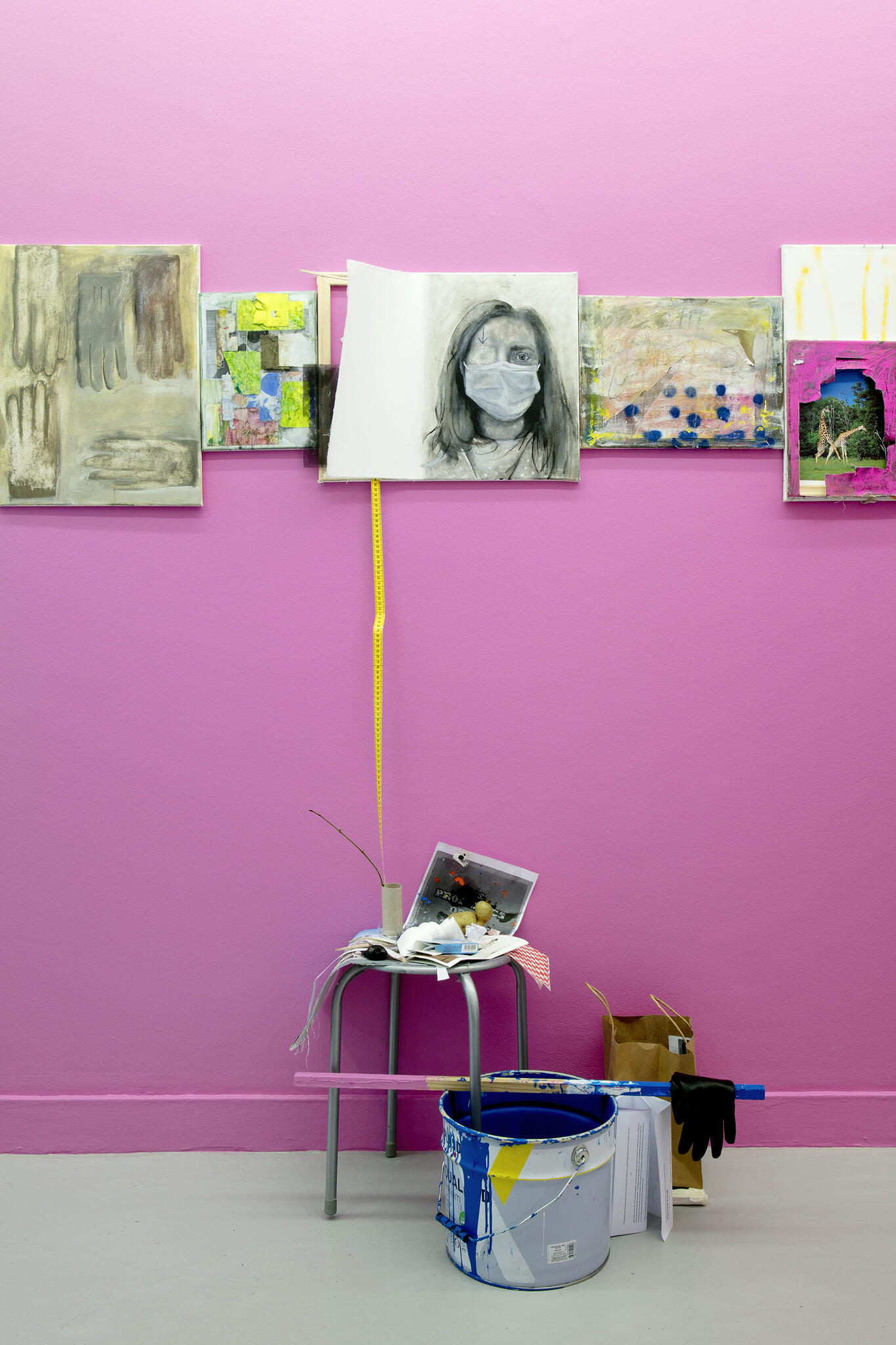
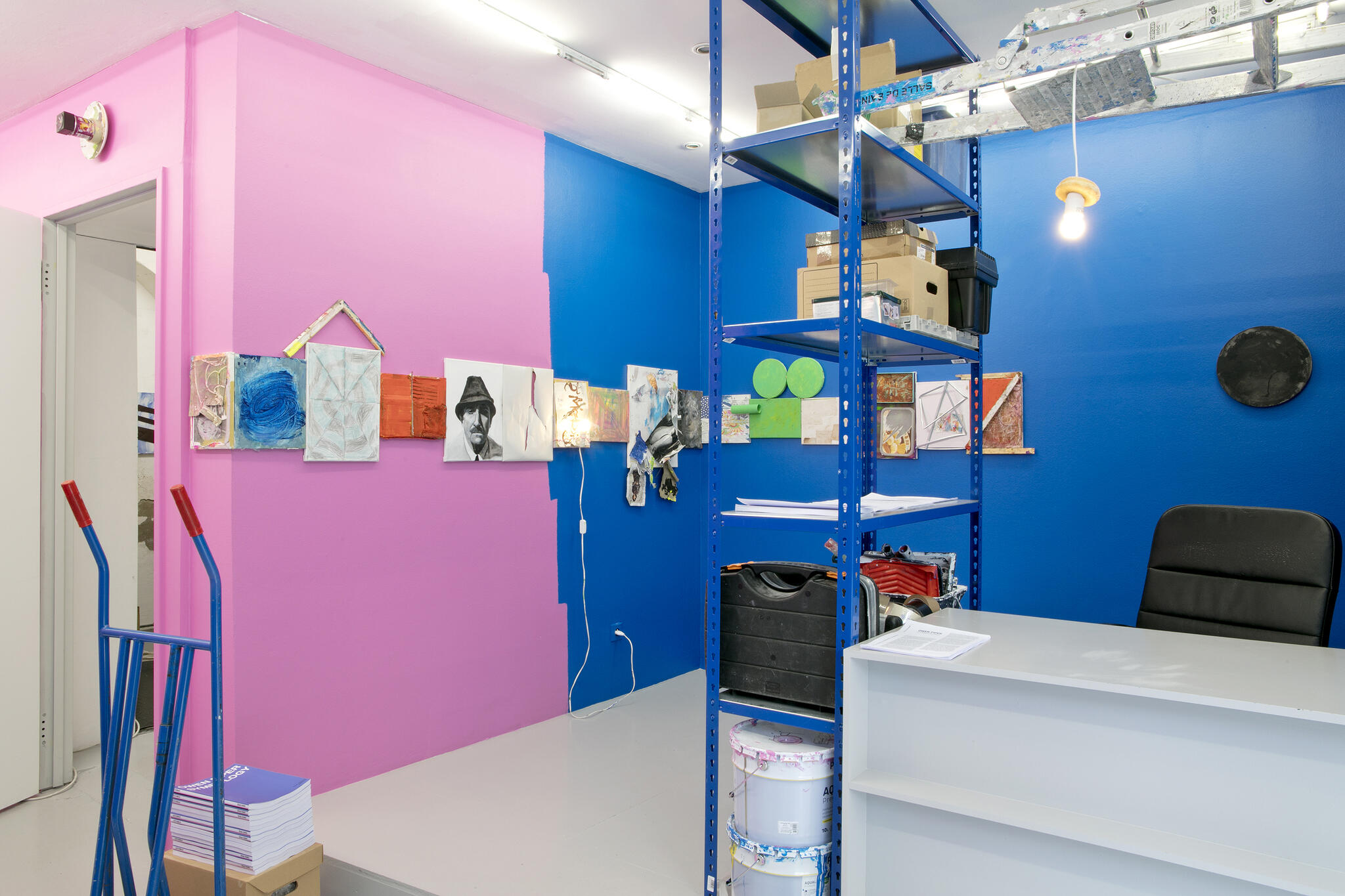
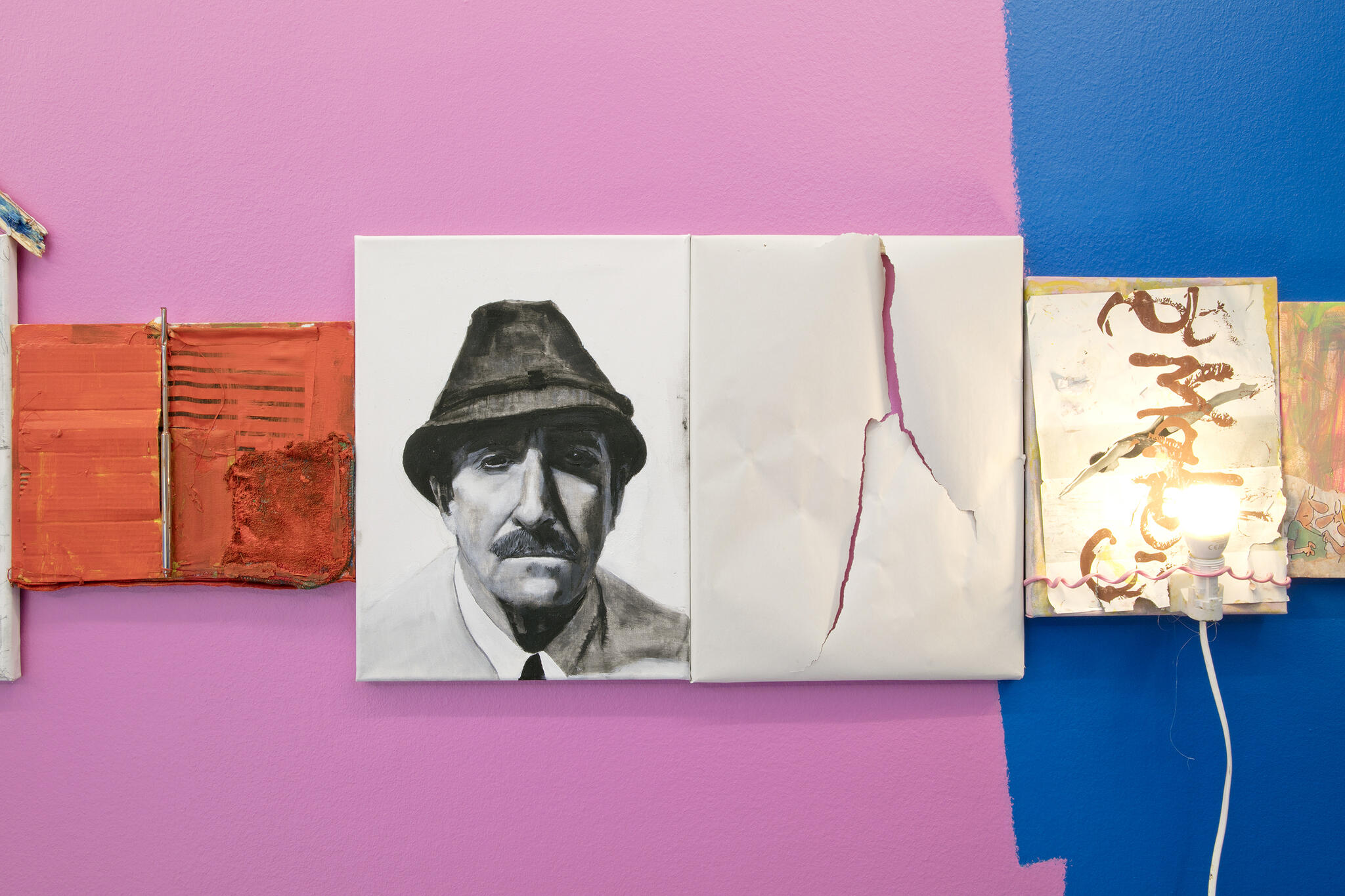
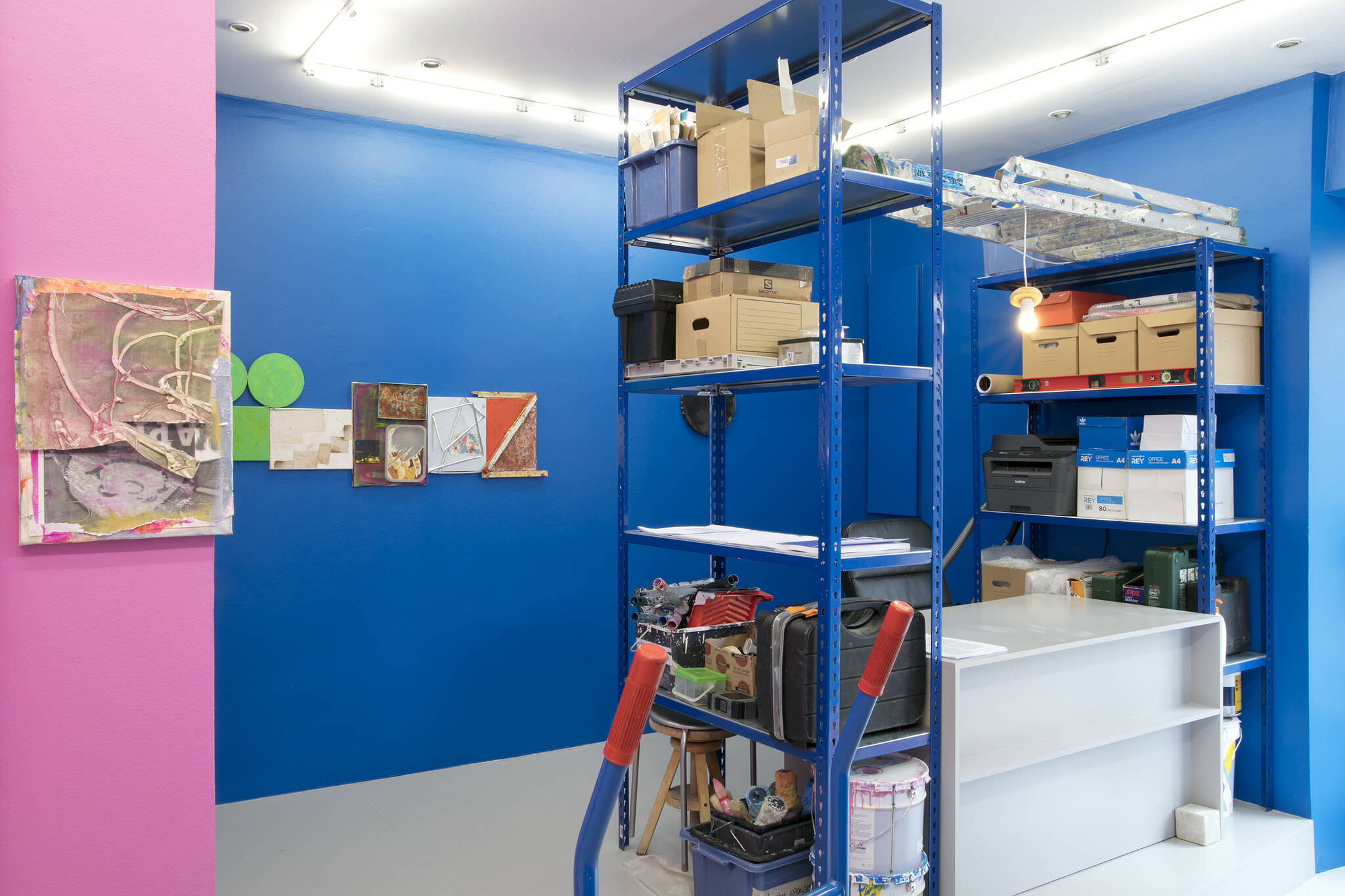
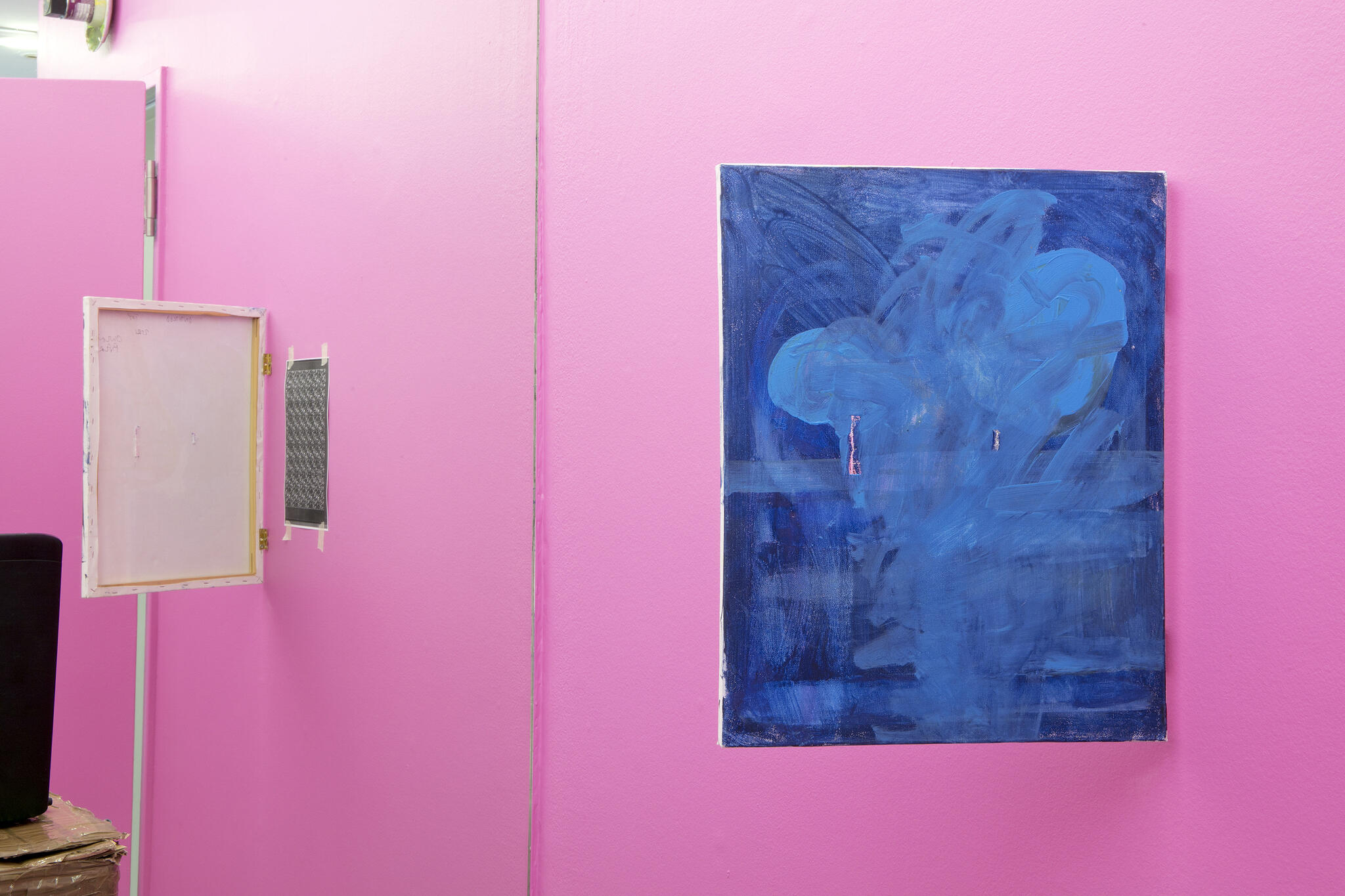
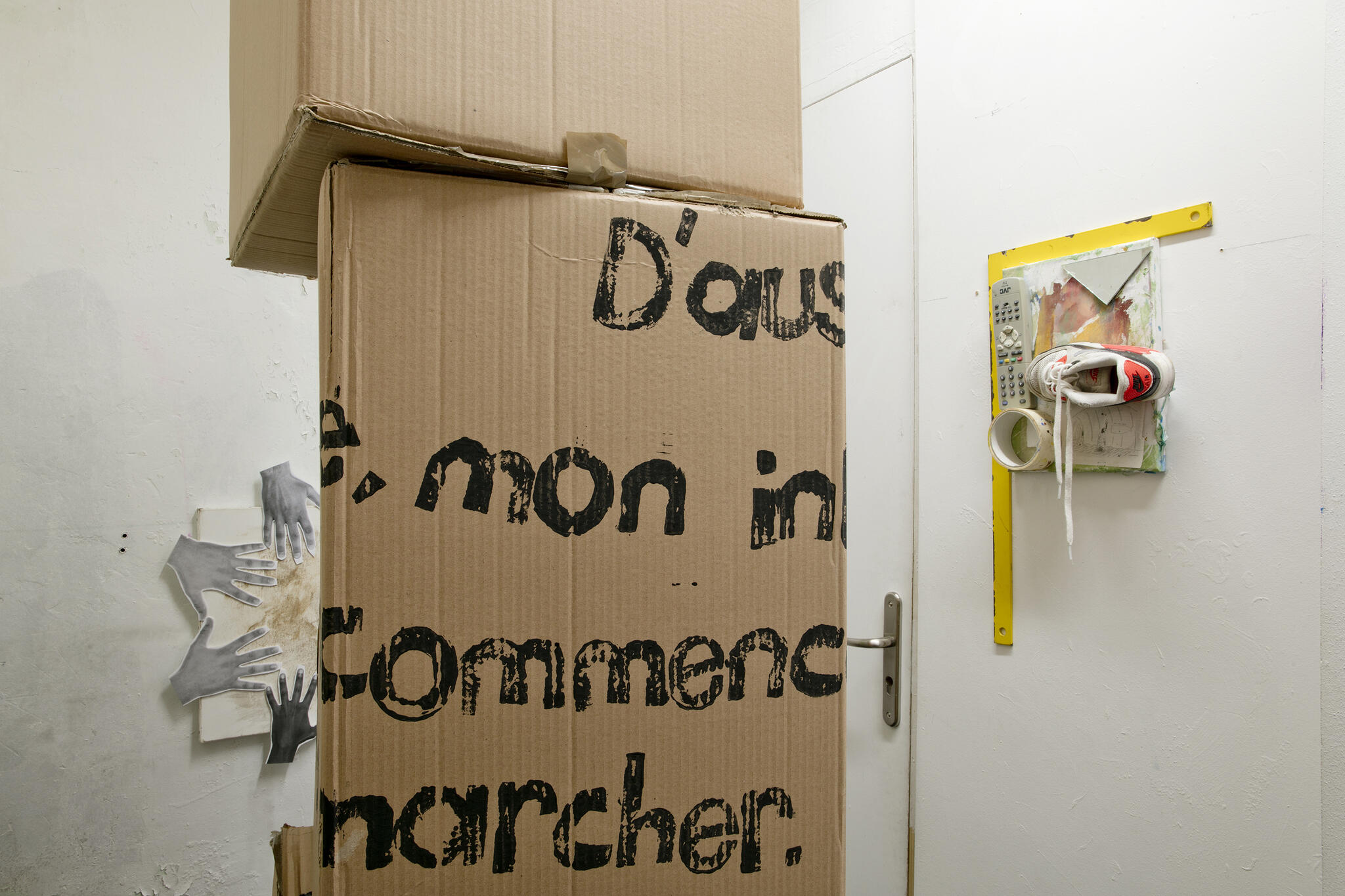

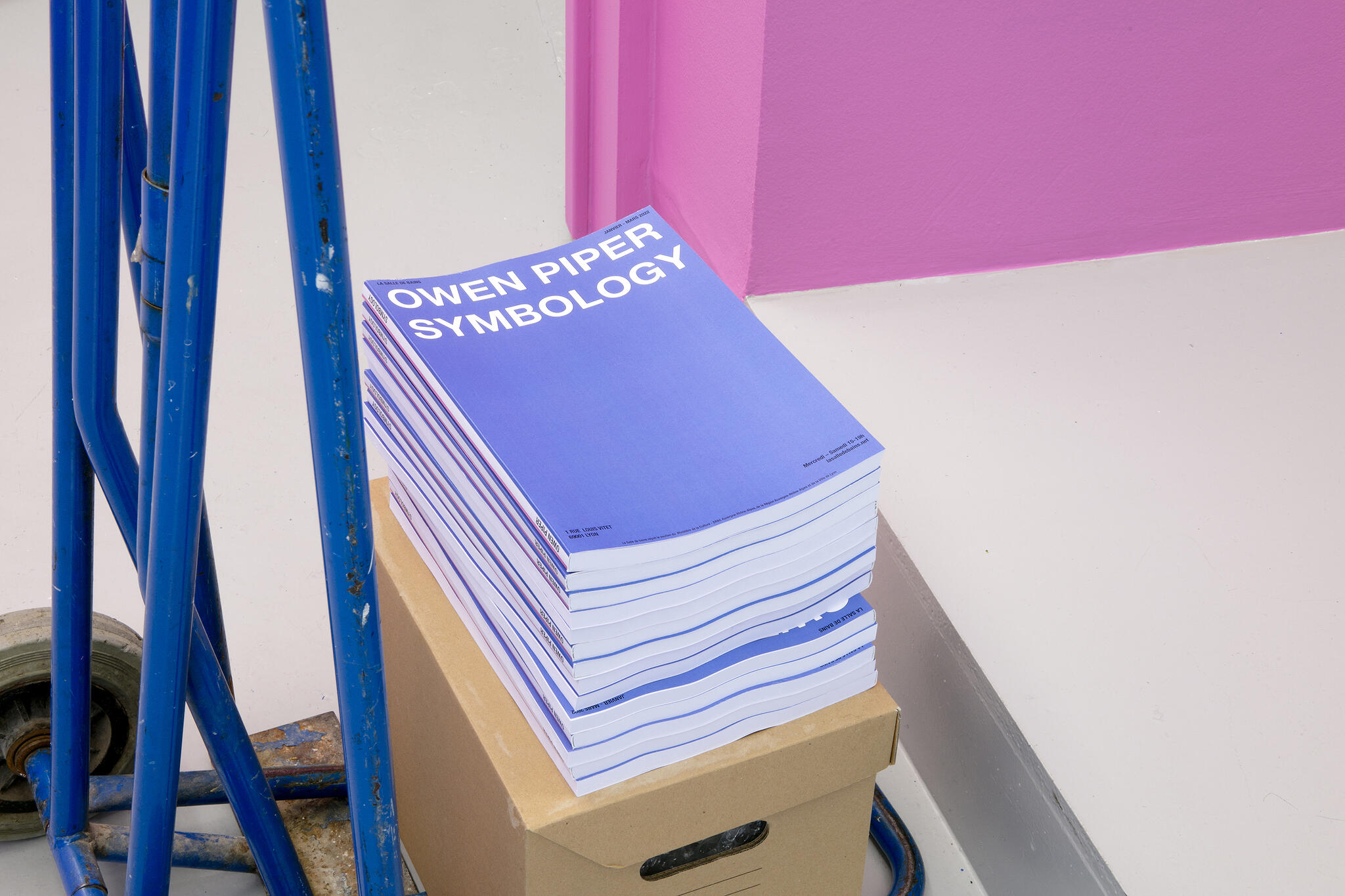
Photo : Jesús Alberto Benitez
Photo : Jesús Alberto Benitez
Symbology - salle 3
Depuis que la Salle de bains s’est installée au 1 rue Louis Vitet, il est parfois arrivé que les trois salles qui forment une exposition se succèdent comme les trois actes d’un scénario écrit à l’avance. Qui s’est rendu sur les lieux en janvier dernier puis en février aura ainsi constaté que les éléments de décor sont restés les mêmes mais n’ont cessé d’être déplacés d’un bout à l’autre de la scène : les étagères du stock, les cartons de transport des œuvres et surtout les murs, qui, alternativement peints en bleu et en rose, répètent l’action d’un célèbre épisode de la Panthère rose et entraînent du même coup l’ensemble de l’exposition d’Owen Piper dans un mouvement perpétuel.
En cherchant bien, l’on tombera sur ce qu’on pourrait prendre pour un point final. Mais en cherchant mieux, l’on risque d’en trouver une multitude, conviant autant d’interprétations de cet épilogue, qu’il se manifeste sous la forme d’un trou noir, d’une mort tragique, d’un écroulement, d’une route barrée, d’un coït, d’un point aveugle, d’un éternel retour... Aussi la (pour)suite de tableaux présentée ici révèle-t-elle des aspects plus sombres de la peinture d’Owen Piper, bien que s’accordant avec l’humour déjà repéré et se fondant dans cette forêt de références à la culture populaire autant qu’à l’histoire de l’art, au cinéma ou à la musique. Cela signale une nouvelle fois ce qui chez l’artiste se traduit plutôt dans la modestie et la dérision que par la violence, c’est-à-dire le démantèlement de tous les mythes qui entourent la peinture et la figure de l’artiste. Et l’on voit bien comment ces expressions peuvent se conjuguer, à l’exemple de ce tableau troué à la Fontana, réduit à une feuille de papier percée et accrochée à côté du portrait de Peter Sellers en inspecteur Clouseau (invoquant ainsi son fameux serviteur chinois, Kato, employé à l’attaquer par surprise dans son propre appartement pour entretenir sa vigilance).
Chaque nouveau tableau d’Owen Piper semble ranimer une foi en la peinture tout en ruinant un peu plus ses prétentions à faire icône. Cela s’opère par des gestes en trop ou en moins, mais aussi quand la toile exhibe impudiquement l’envers du tableau qui, bien sûr, n’a rien à divulguer ou alors un peu de bazar. La présentation des œuvres bord à bord, dans un effet de remplissage, porte le même projet – tout en singularisant étrangement chaque peinture – en annulant aussi la dimension narrative de l’exposition. Car autant être franc : le scénario n’est jamais ficelé à l’avance, en témoigne la compilation de mails échangés avec l’artiste que renferme comme une pièce à conviction l’édition Symbology produite pour le dernier volet de l’exposition. La ligne de tableaux que le regard parcourt spontanément dans le sens de lecture ne veut rien dire ; elle ne propose aucune solution à l’enquête. Au contraire, s’y glissent de nouvelles coïncidences qui se présentent comme des indices aux esprits férus d’interprétation et à tendance maniaque : ainsi de ces gants de cuir dont il sera aussi question dans l’édition... Non, l’ensemble de tableaux exposé ici n’est que la totalité des tableaux envoyés par l’artiste depuis Glasgow et qui n’ont pas été montrés dans les salles 1 et 2.
Mais revenons à la Panthère rose et aussi à Nabokov. Dans un texte qui était disponible dans la salle 2 sous le titre Quiet Please, parmi les rares textes non empruntés mais écrits par l’artiste, Owen Piper décrit son rapport à la lecture en commençant par citer Nabokov affirmant que l’implication physique que demande la lecture, soit le déplacement des yeux de gauche à droite, le fait de tourner les pages, s’interpose entre le lecteur et son interprétation. Ainsi, « on ne peut pas lire un livre, seulement le relire ». Compte-tenu des deux mouvements, rotatif et giratoire, auxquels le regard est ici invité, cette réflexion pourrait assez bien coller à l’exposition. Certes, l’on avait omis de préciser ici que le titre, Symbology, renvoie à une exégèse d’une nouvelle de l’auteur américain d'origine russe, Signes et Symboles (1948). Il y est question d’un jeune homme interné en psychiatrie car souffrant d’une « névrose référentielle », selon la formule médicale, lui faisant apparaître tous les éléments du paysage (nuages, rivières, arbres, feuilles) comme des émetteurs de signes à son intention. Mais la nouvelle distille bien plus de signes et de symboles intrigants dans l’environnement ordinaire des vieux parents inquiets des pulsions de mort de leur fils.
Owen Piper est de ces esprits qui se penchent sur les signes qui fourmillent dans le quotidien, en les suspectant ou non de faire sens, dans une enquête permanente, comme celle qui conduit Dale Cooper (Twin Peaks) à accepter de vivre dans un monde complexe plutôt que de trouver la solution de l’énigme – Clouseau lui, trouve toujours la solution, mais par accident. Cette pulsion sémiotique se traduit dans les objets qui se retrouvent dans ses œuvres, mais aussi les relevés photographiques qu’il réalise chaque jour dans la rue. D’où son intérêt particulier pour les graffiti, comme celui qui inspira le titre de l’exposition annulée en 2021, « Grow the revolution » ou cet étrange blaze, « leaf », dont il a suivi la piste dans les rues de Glasgow et qu’il redistribue sous forme de carte postale, rendant la force du « signe vide » – cette manière de « retourner l’indétermination contre le système » dont parle Jean Baudrillard(1), reprendre l’espace public en y inscrivant sa présence anonyme – disponible à adresser un message. Dans le texte cité plus haut, l’artiste confie aussi un rêve secret de devenir un jour graffeur. En attendant ses potato prints affirment l’écriture en tant que geste, qui ici s’empare, modestement, d’un pilier de cartons dans une réserve.
Since la Salle de bains moved to its current address at 1 rue Louis Vitet, there have been times when the three rooms that make up a show have followed one another like the three acts of a storyline written in advance. Anyone who stopped by last January and then again in February will have realized that the elements of the setting have remained the same but have been moved over and over from one end of the stage to the other, be it the shelving of the stockroom, the boxes used to move the artworks, and especially the walls, which have been painted alternately blue and pink, repeating the action in a famous episode of the Pink Panther while throwing the whole of Owen Piper’s exhibition into perpetual motion.
If viewers look carefully, they will surely stumble on something that they could see as a conclusion. However, if they search more carefully, they are likely to find plenty of such end points, inviting so many interpretations of this epilogue, whether it takes the form of a black hole, a tragic death, a collapse, a blocked road, an instance of sexual intercourse, a blind spot, or an eternal recurrence… And so the (on-going) end of the series of paintings featured here reveals darker aspects of Piper’s pictorial output, even though they are in keeping with the humor that has already been pointed out, and melt into the forest of references to pop culture as much as to the history of art, film, and music. This announces yet again what takes shape in the artist’s work, tinged with modesty and mockery rather than violence, that is, the dismantling of all the myths surrounding painting and the figure of the artist. And we can easily see how these expressions can combine, just like that painting that is cut à la Lucio Fontana, reduced to a sheet of paper with holes hung next to a portrait of Peter Sellers as Inspector Clouseau (suggesting Clouseau’s famous Chinese manservant Cato, who is employed to attack the detective by surprise in his own home in order to keep his senses sharp and ready for anything).
Each new picture by Piper seems to revive our faith in painting while undermining a little bit more its aspirations to be an icon. This is achieved through gestures that are too many or not enough, but also when the canvas indiscreetly shows off the back of the picture, which of course has nothing to disclose or is a bit of a mess. Displaying the artworks side by side generates an effect of padding things out; this sustains the project by canceling the show’s narrative dimension as well – while also oddly individualizing each painting. Because we might as well be frank, that is, the storyline is never nicely tied up in advance, witness the compilation of emails exchanged with the artist which is included like a piece of incriminating evidence in the Symbology publication put out in the last iteration of the show. The line of paintings that the eye spontaneously follows as if reading a line of print means nothing; it offers no solution to the investigation. On the contrary, new coincidences slip in which pass for clues in the eyes of those who are keen on interpretation and have an obsessive bent. So it goes for those leather gloves that figure in the publication… No, the set of paintings exhibited here is nothing more than the totality of the paintings sent by the artist from Glasgow that weren’t shown in rooms 1 and 2.
But let’s come back to the Pink Panther as well as Nabokov. In a text that was available in room 2 titled Quiet Please, among the rare texts written by the artist and not borrowed from others, Piper describes his relationship to reading and begins by quoting Nabokov, who asserts that the physical involvement that reading requires, that is “the very process of laboriously moving our eyes from left to right” and turning the page “stands between us and artistic appreciation.” Thus, “one cannot read a book: one can only reread it.” Given the two movements, rotary and gyratory, to which our eyes are invited here, this reflection could just as easily apply to the exhibition. Of course we have forgotten to point out that the title Symbology is also a reference to a critical interpretation of a short story by the Russian-born American author called Signs and Symbols (1948). At the heart of the story is a young man who is confined to a psychiatric hospital because he suffers from “referential mania,” according to the terminology proposed in “an elaborate paper in a scientific monthly,” which makes him believe that all the elements of the landscape around him (clouds, rivers, trees, individual leaves) are emitting signs about him and for him to read. Yet the short story hints at many more intriguing signs and symbols found in the ordinary surroundings of his elderly parents, who are worried about their son’s suicidal urges.
Owen Piper is one of those minds that pay attention to the signs teeming in daily life, suspecting or not that they make sense, in a permanent investigation, a never-ending examination, like the one that eventually leads Dale Cooper to accept living in a complex world rather than find the solution to the mystery – Clouseau, on the other hand, always finds the solution but only by accident. This semiotic drive takes shape in the objects that are found in the artist’s works but also in the photographic “records” he shoots each day in the street. Hence his special interest in graffiti, like the message that inspired the title of his show that was canceled in 2021, “Grow the revolution,” or the strange tag, “leaf,” that he trailed around Glasgow and redistributed as a postcard, making the power of the “empty sign” – a way to “turn indeterminacy against the system” which Jean Baudrillard(1) speaks of, to take back public space by inscribing one’s anonymous presence there – available to send a message. In the text quoted above, the artist also confides a secret dream of becoming a graffiti artist one day. In the meantime, his potato prints assert writing as a gesture, which modestly takes over here a stack of boxes in a storeroom.
(1) Jean Baudrillard, Kool Killer ou l'insurrection par les signes, 1975
(1) Jean Baudrillard, Kool Killer or the Insurrection of Signs, 1975
translation : John O'Toole
Liste des œuvres :
List of works :
Leaf, 2022
cartes postales
Line, 2022
techniques mixtes, collage et peinture sur toile
The Pink Phink?, 2022
film sur ordinateur, 7’10’’
Untitled, 2022
peinture sur toile
Clock, 2022
peinture et collage sur assiette
Untitled, 2022
collage, objet trouvé et peinture sur toile
Symbology, 2022
livre d’artiste, 50 exemplaires
Line continued, 2022
techniques mixtes, collage et peinture sur toile
Untitled black dot, 2022
peinture sur toile
Boring, boring, painting, 2022
poèmes, impression jet d'encre sur papier
Marxism for dummies, 2022
performance le soir du vernissage (vernis sur ongle)
Space was the place, 2022
collage et peinture sur toile
China Ferrari sex orgy death crash, 2022
collage et peinture sur toile, lecteur de cassette audio
Cravate peinture, 2022
collage et peinture sur toile
Tower, 2022
impressions à la pomme de terre sur cartons d’emballage
Green reel to reel, 2022
collage et peinture sur toile
Séance avec pluie de sang, 2022
collage et peinture sur toile
You are here, 2022
collage, objets trouvés et peinture sur toile
The end, 2022
peinture sur toile
Postcards
Line, 2022
Mixed media, collage and painting on canvas
The Pink Phink?, 2022
Video on laptop, 7’10’’
Untitled, 2022
Painting on canvas
Clock, 2022
Painting and collage on plate
Untitled, 2021
Collage, mixed media and painting on canvas
Symbology, 2022
Artist book, 50 copies
Line continued, 2022
Mixed media, collage and painting on canvas
Untitled black dot, 2022
Painting on canvas
Boring, boring, painting, 2022
Poems, prints on paper
Marxism for dummies, 2022
Performance during the opening (nailpolish)
Space was the place, 2022
Collage and painting on canvas
China Ferrari sex orgy death crash, 2022
Collage and painting on canvas, audio tape player
Cravate peinture, 2022
Collage and painting on canvas
Tower, 2022
Potato prints on cardboard boxes
Green reel to reel, 2022
Collage and painting on canvas
Séance avec pluie de sang, 2022
Collage and painting on canvas
You are here, 2022
Collage, mixed media and painting on canvas
The end, 2022
Painting on canvas
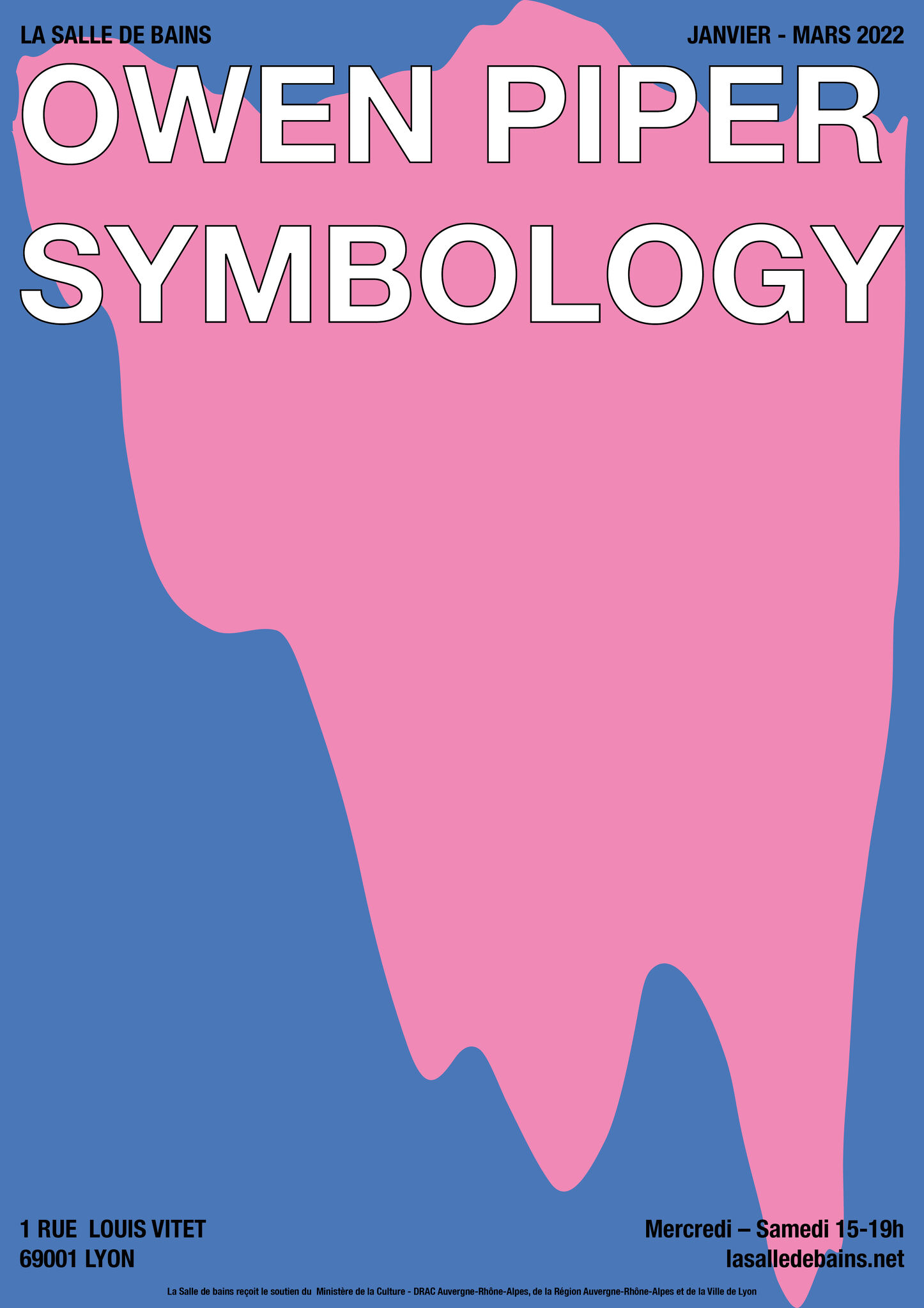
Owen D. Piper (1975, Londres), vit et travaille à Glasgow.
Ses dernières expositions personnelles et collectives regroupent notamment : I’ll be your city, Good press, Glasgow, 2019 ; Elle disait bonjour aux machines, Villa du parc, Annemasse, 2019 ; Mash, avec Cheryl Donegan, Downstairs Projects, New York, 2018 ; How to talk dirty and influence people, avec Lili Reynaud Dewar, SALTS, Birsfelden, Suisse, 2016 ou encore Deep screen, Parc Saint Leger, Pougues Les Eaux, 2015.
Parmi ses publications récentes, citons Images du monde, visite d’atelier, éditions Connoisseurs, 2018 et Le jeu de l’image, avec Charlie Hammond, autoédition, 2019.
Owen D. Piper (1975, London), lives and works in Glasgow.
Recent solo and group exhibitions include: I'll be your city, Good press, Glasgow, 2019; Elle disait bonjour aux machines, Villa du parc, Annemasse, 2019; Mash, with Cheryl Donegan, Downstairs Projects, New York, 2018; How to talk dirty and influence people, with Lili Reynaud Dewar, SALTS, Birsfelden, Switzerland, 2016 or Deep screen, Parc Saint Leger, Pougues Les Eaux, 2015.
His recent publications include Images of the world, studio visit, Connoisseurs Editions, 2018 and The game of the image, with Charlie Hammond, self-publishing, 2019.
